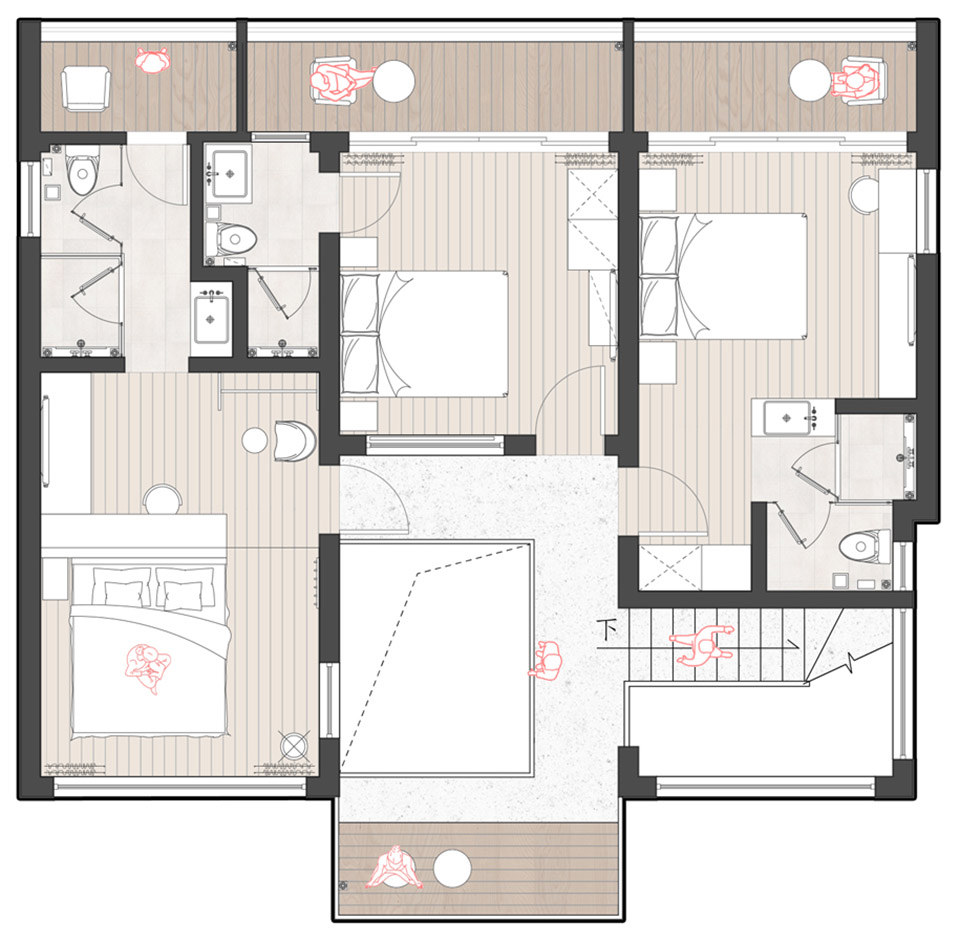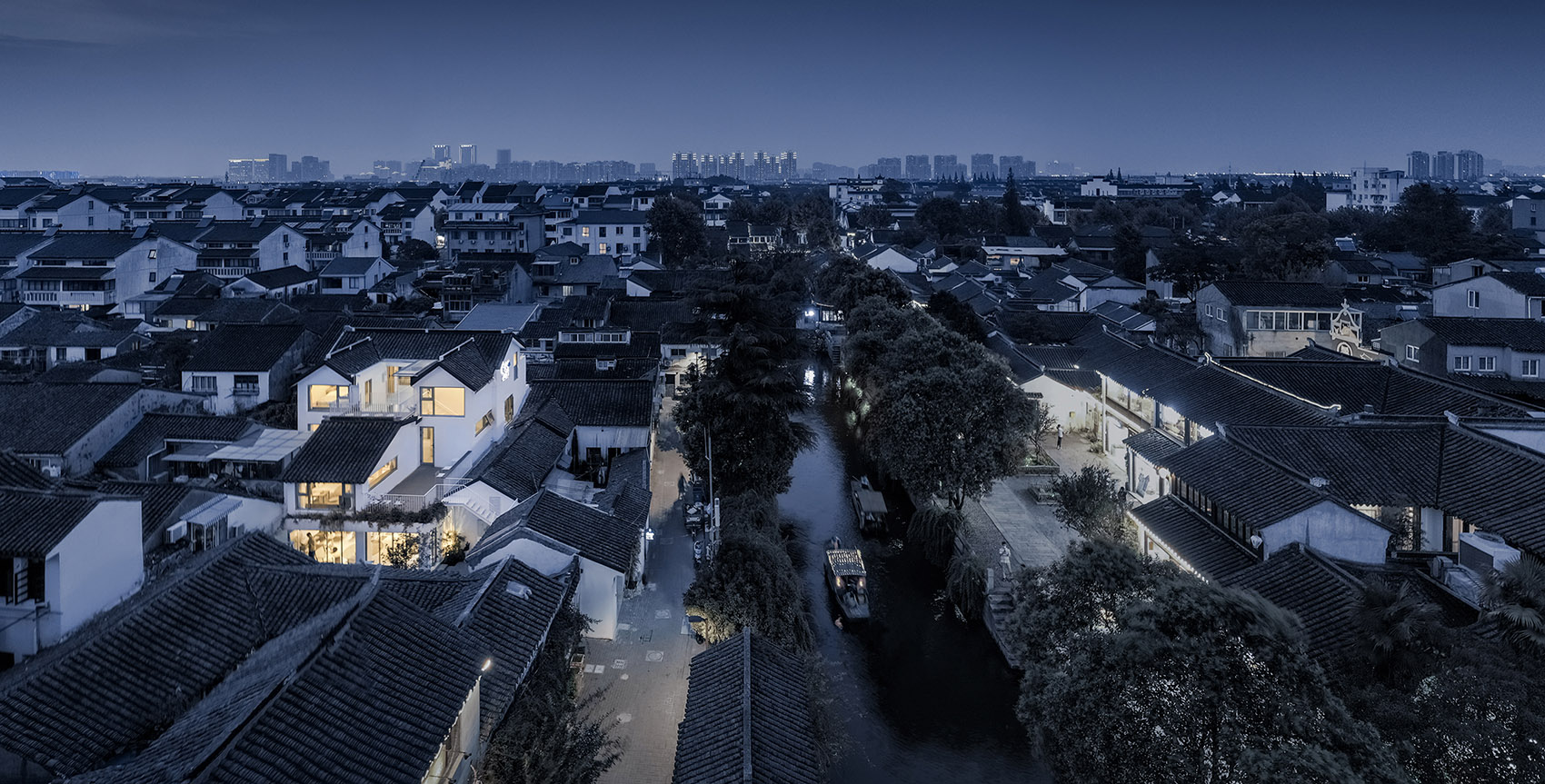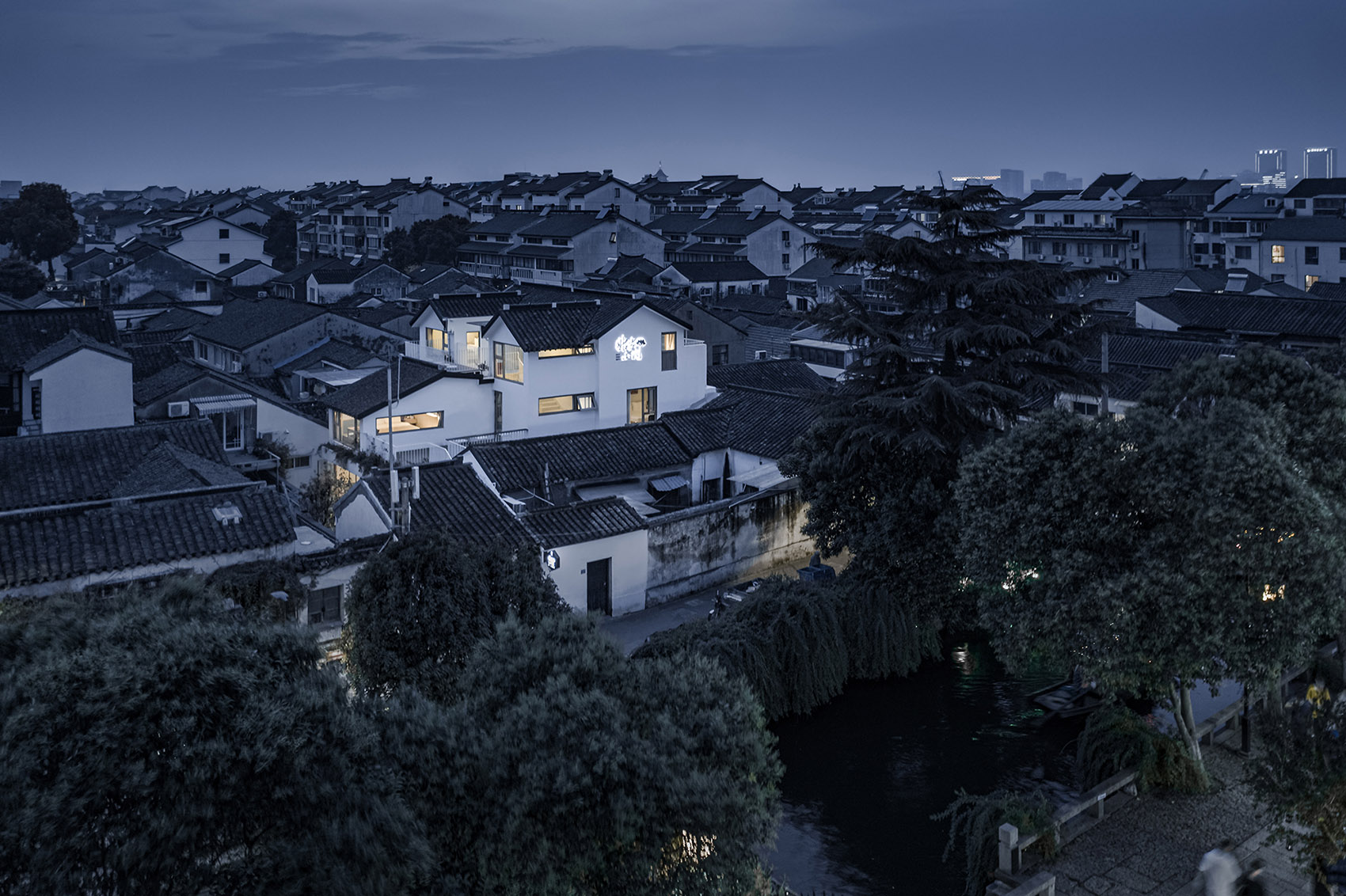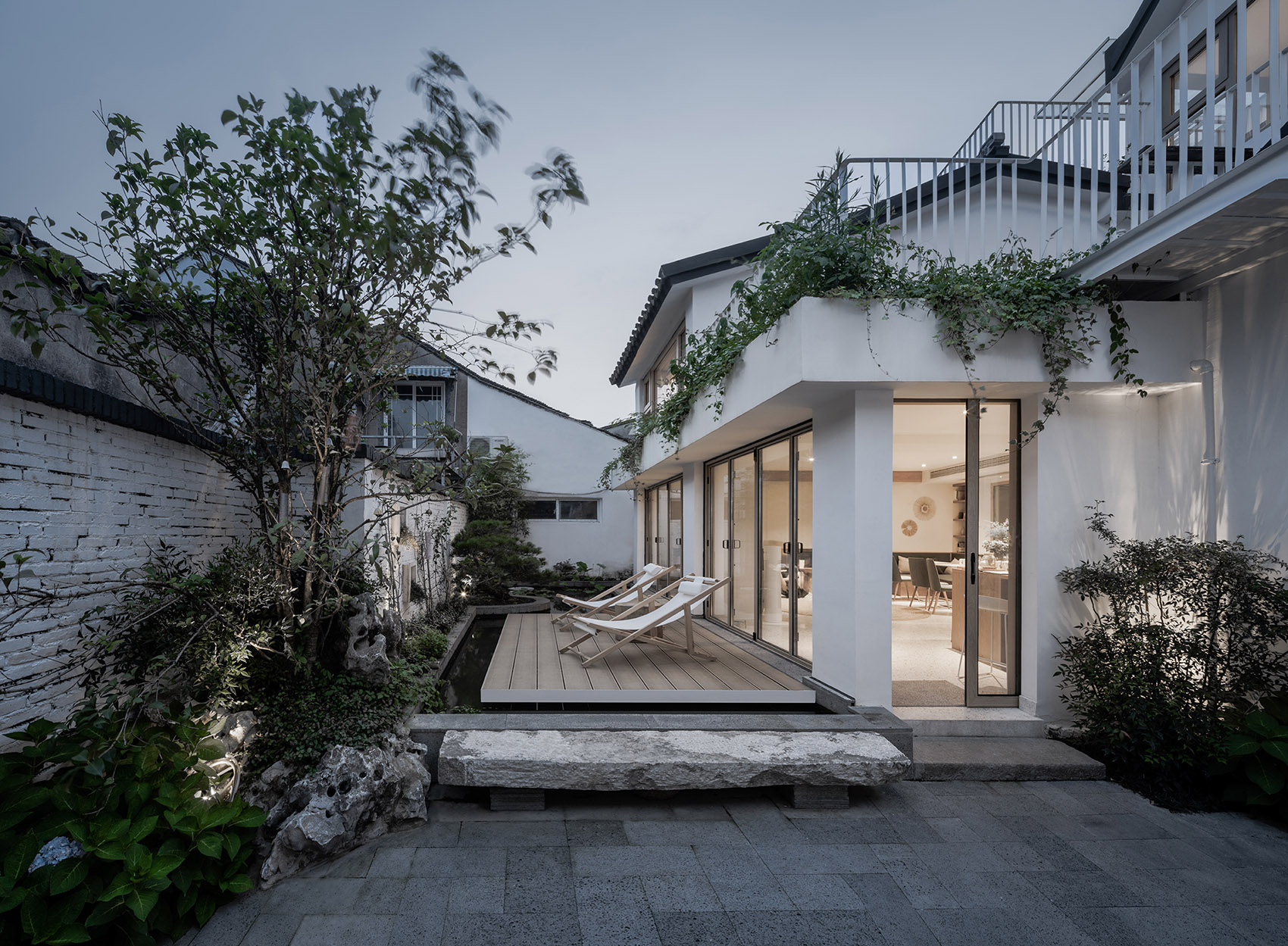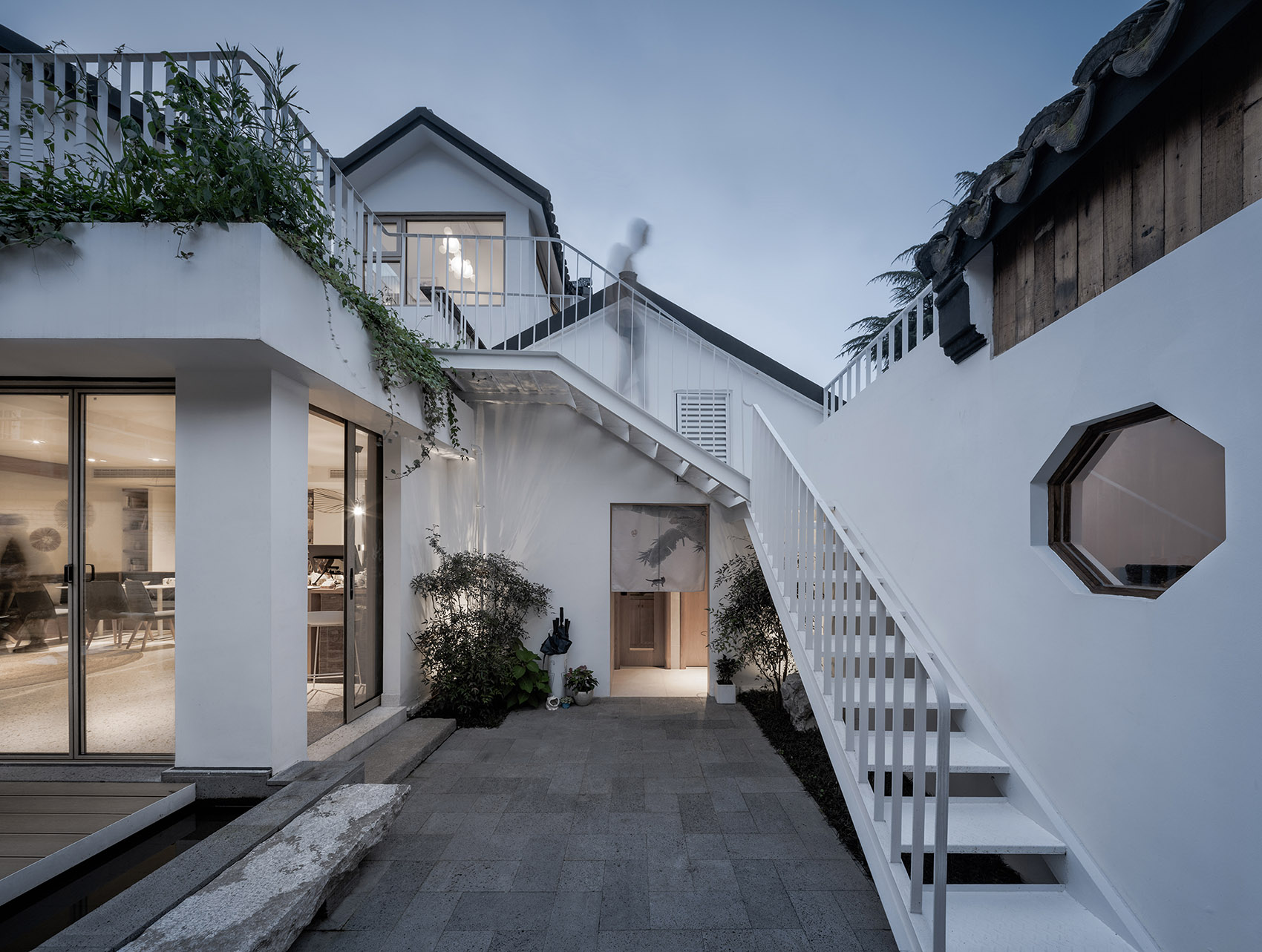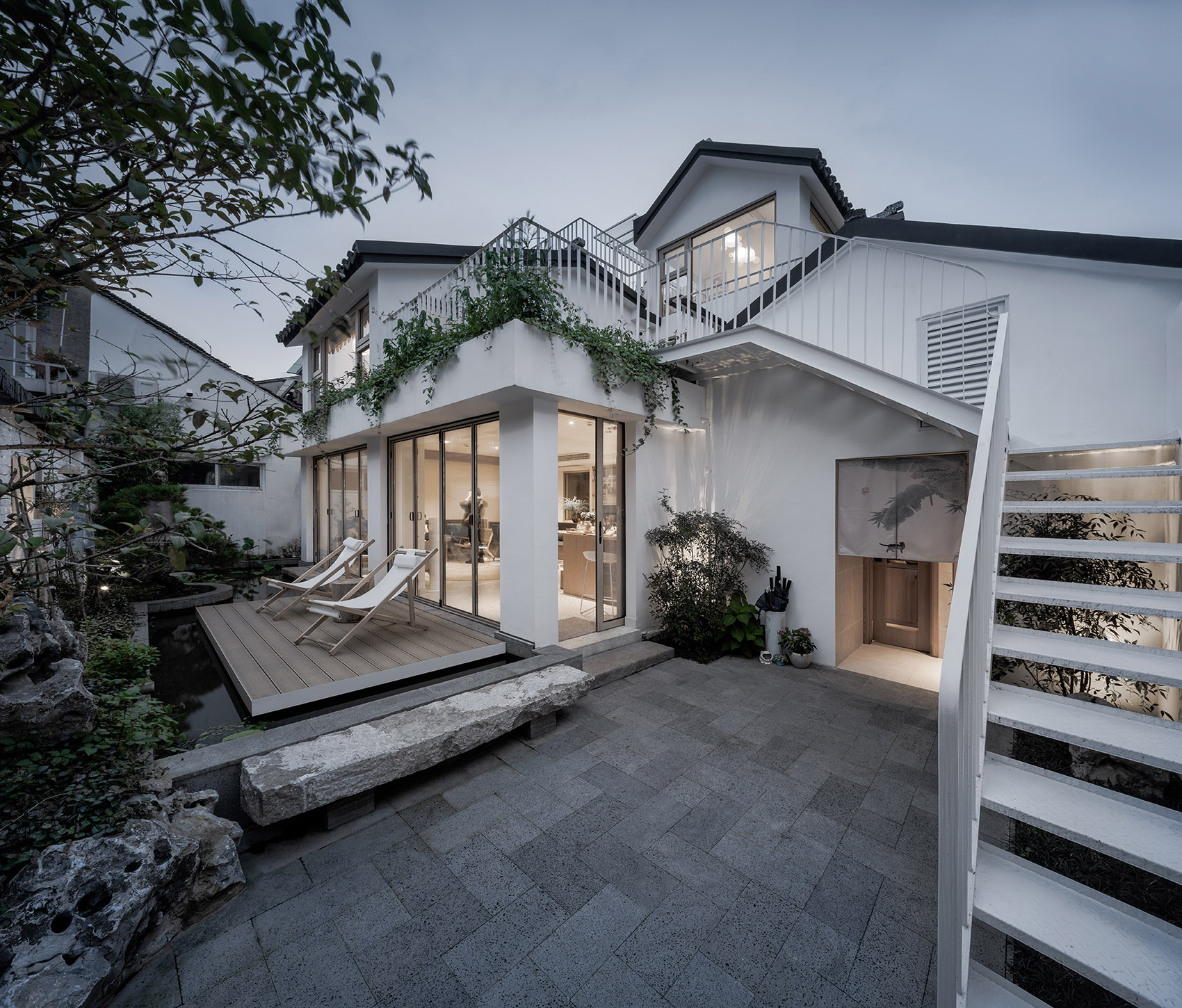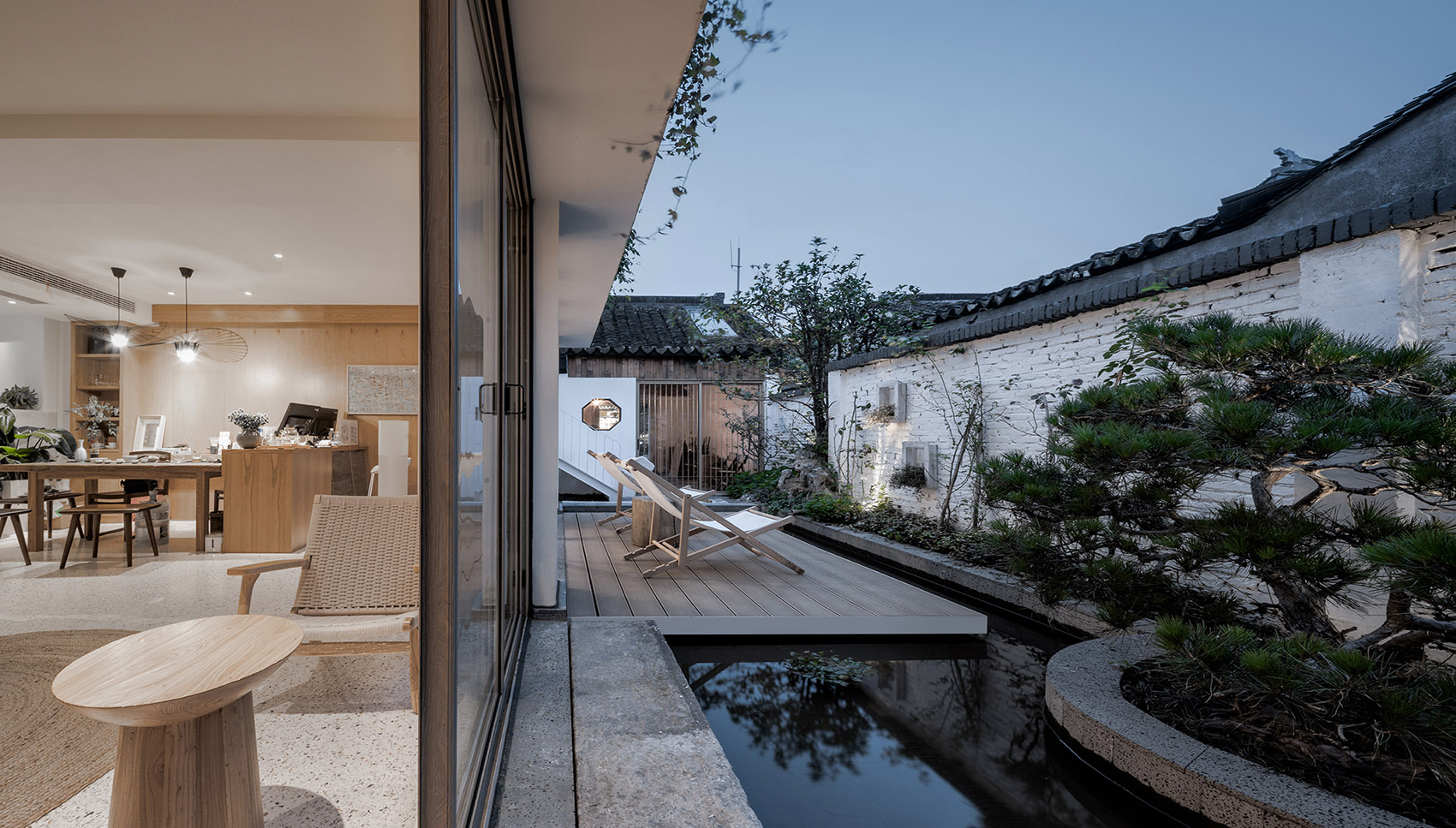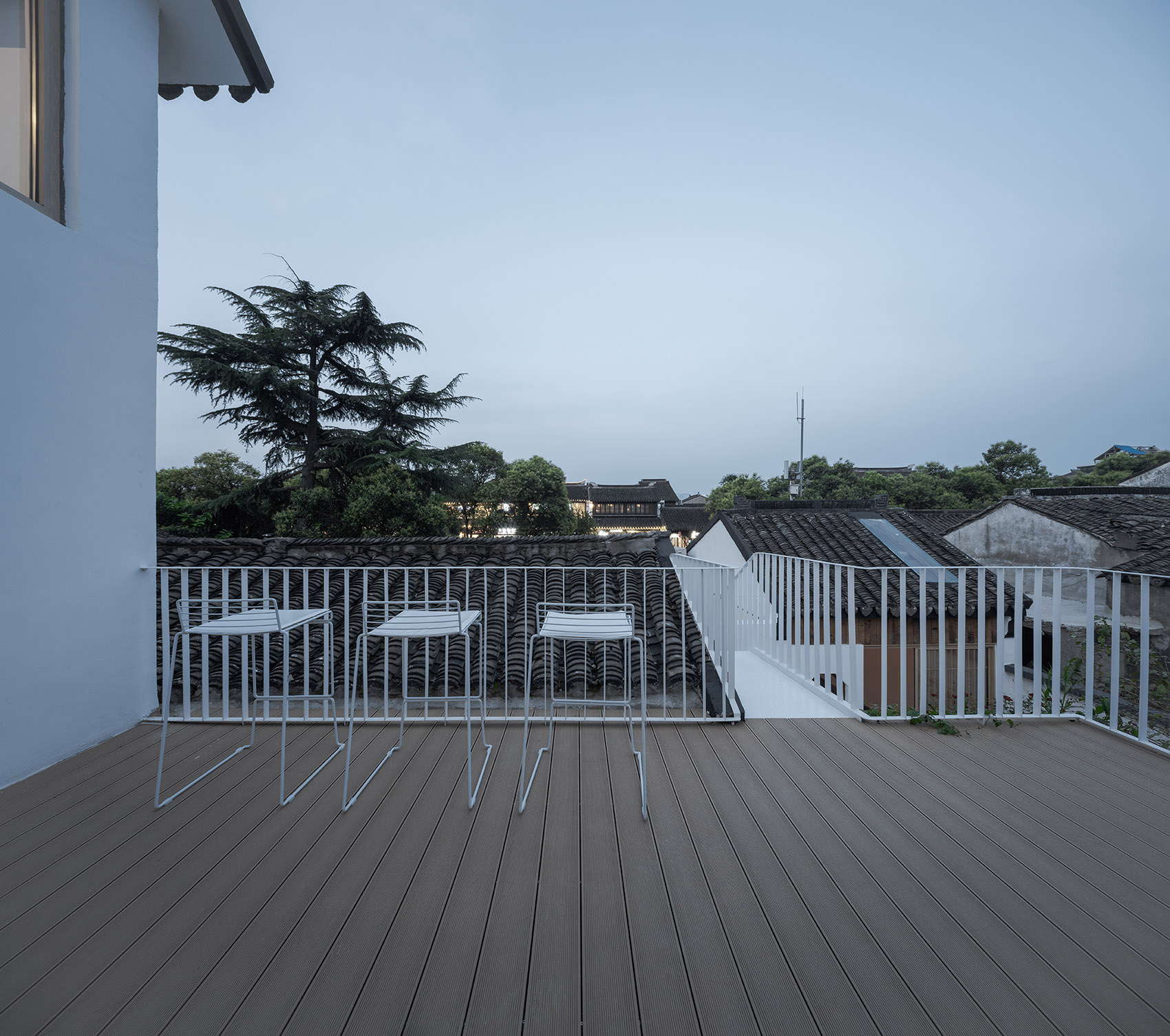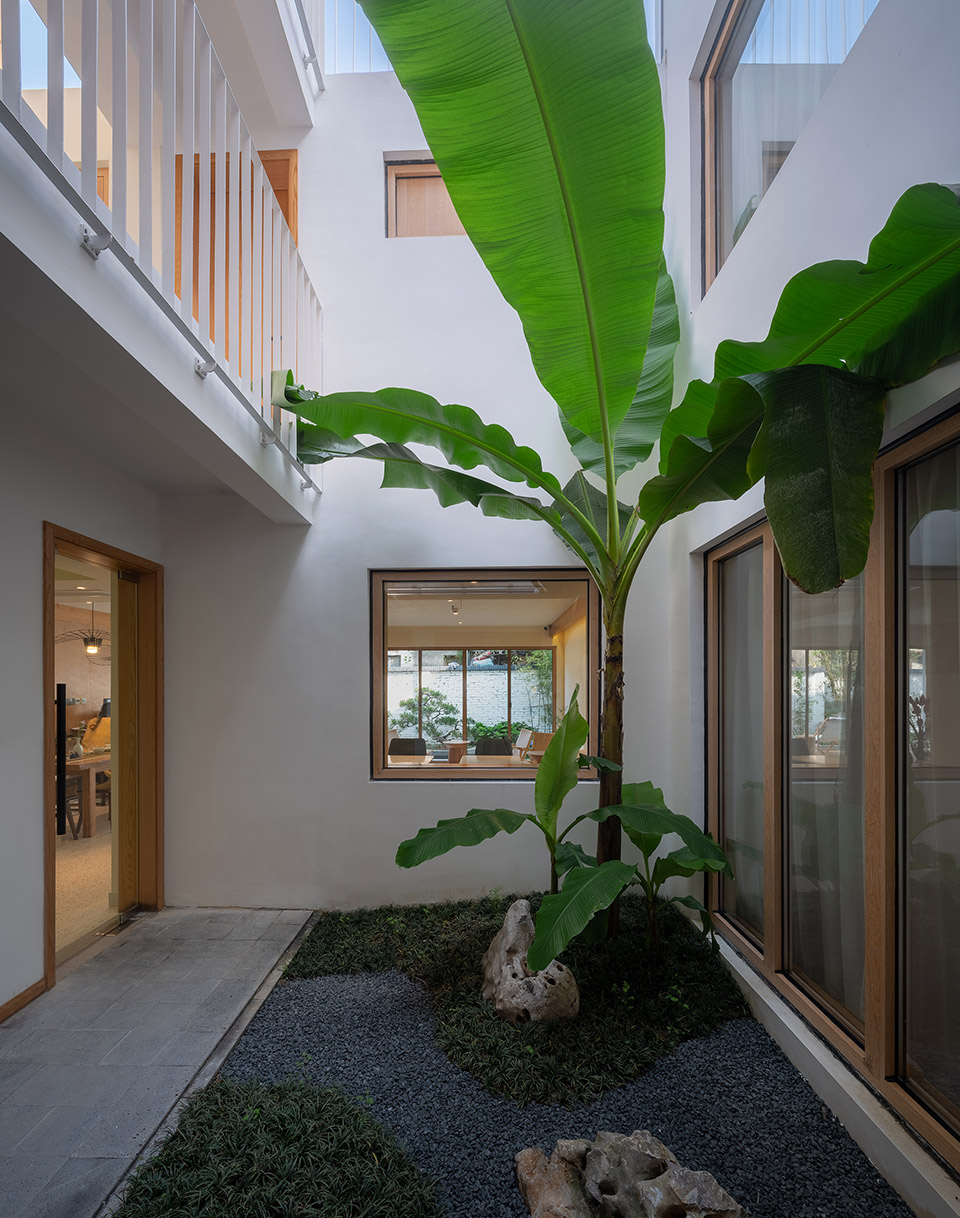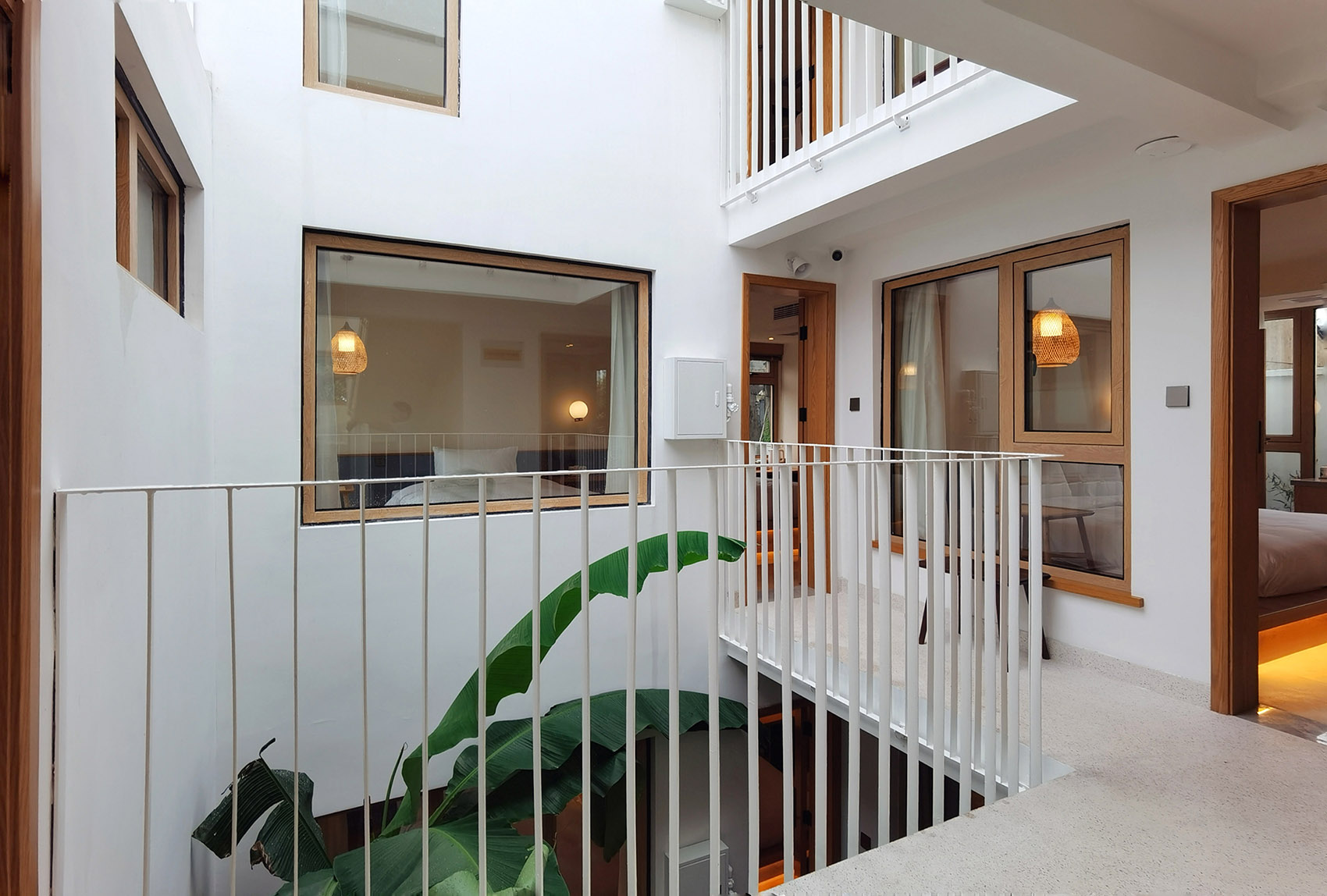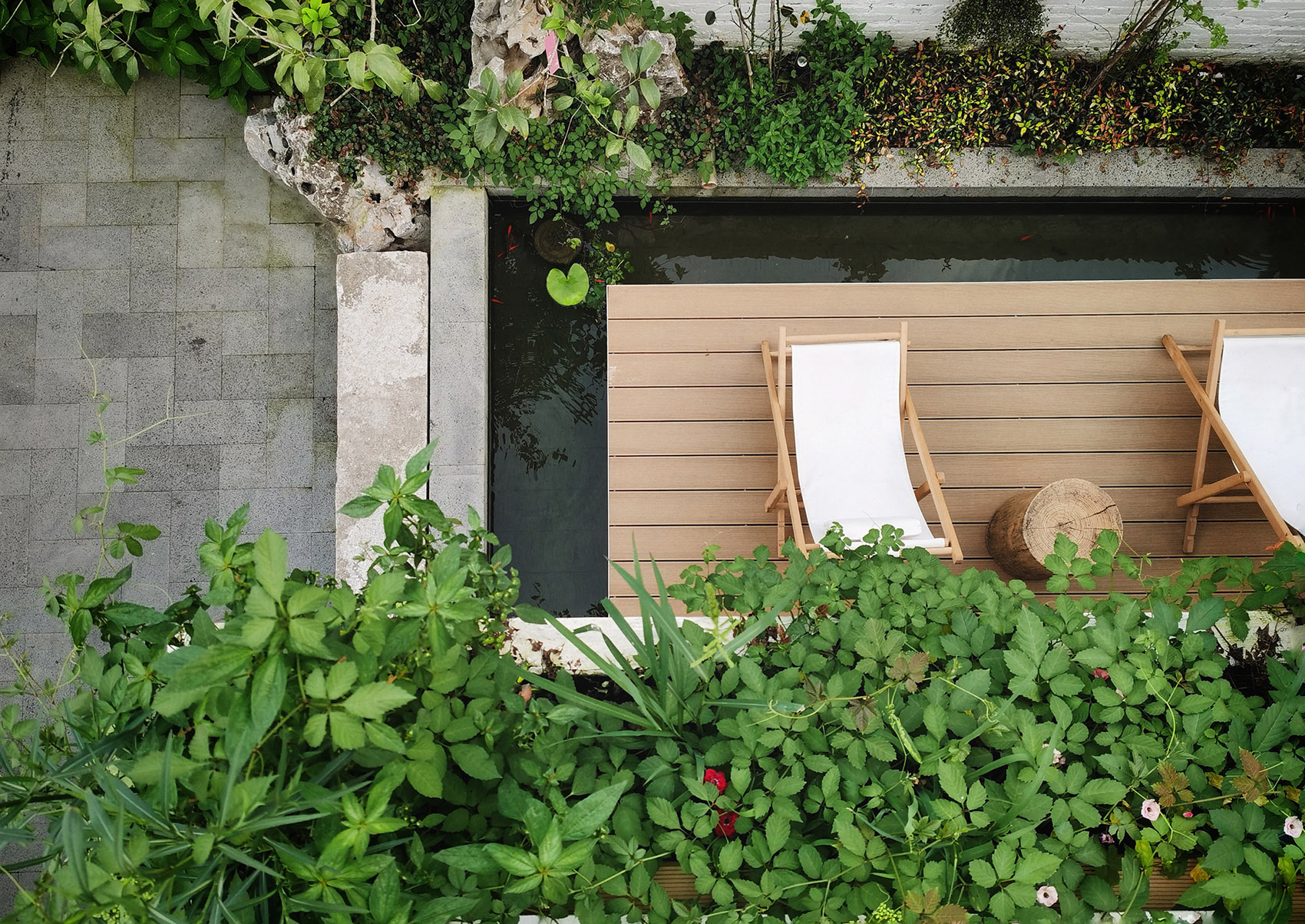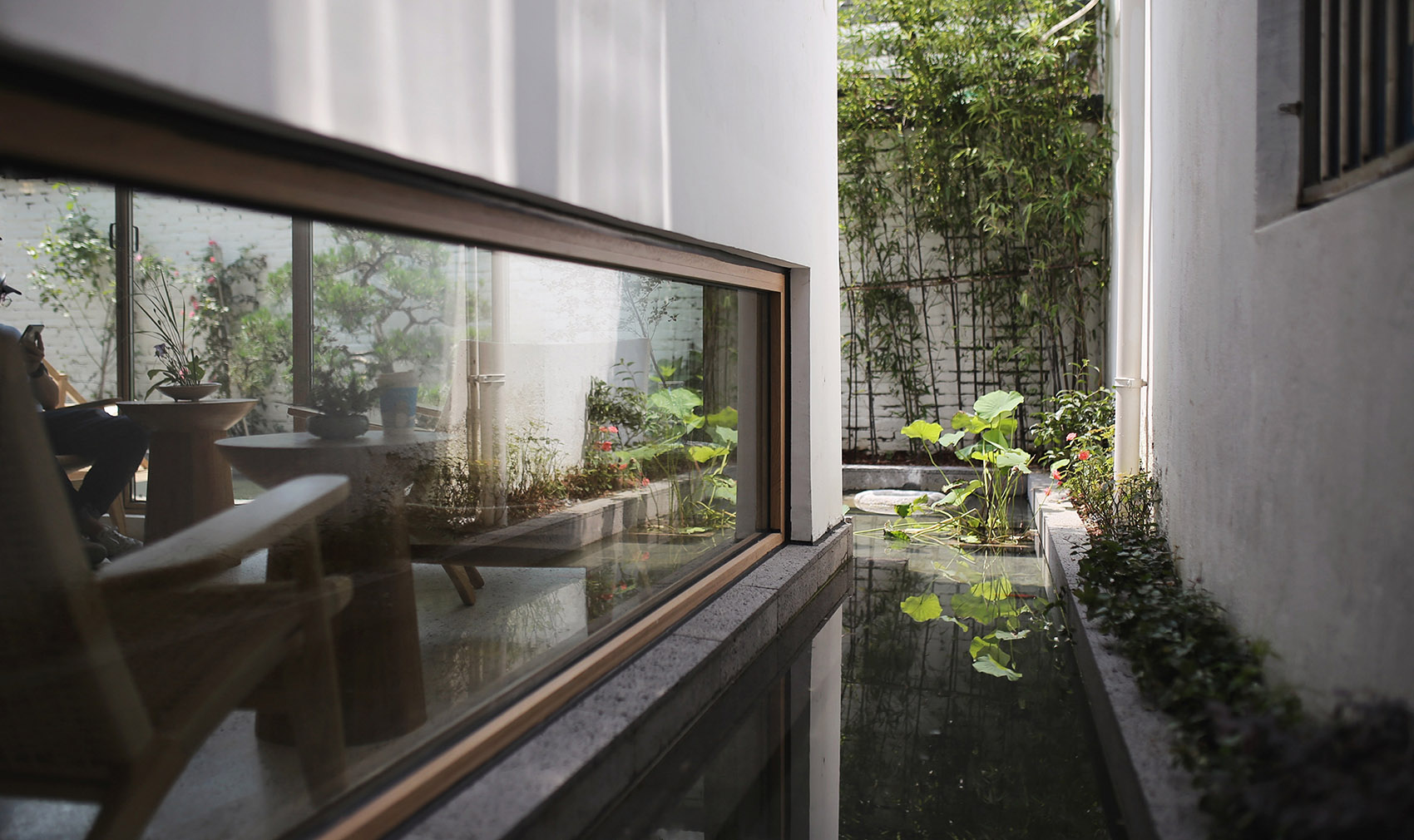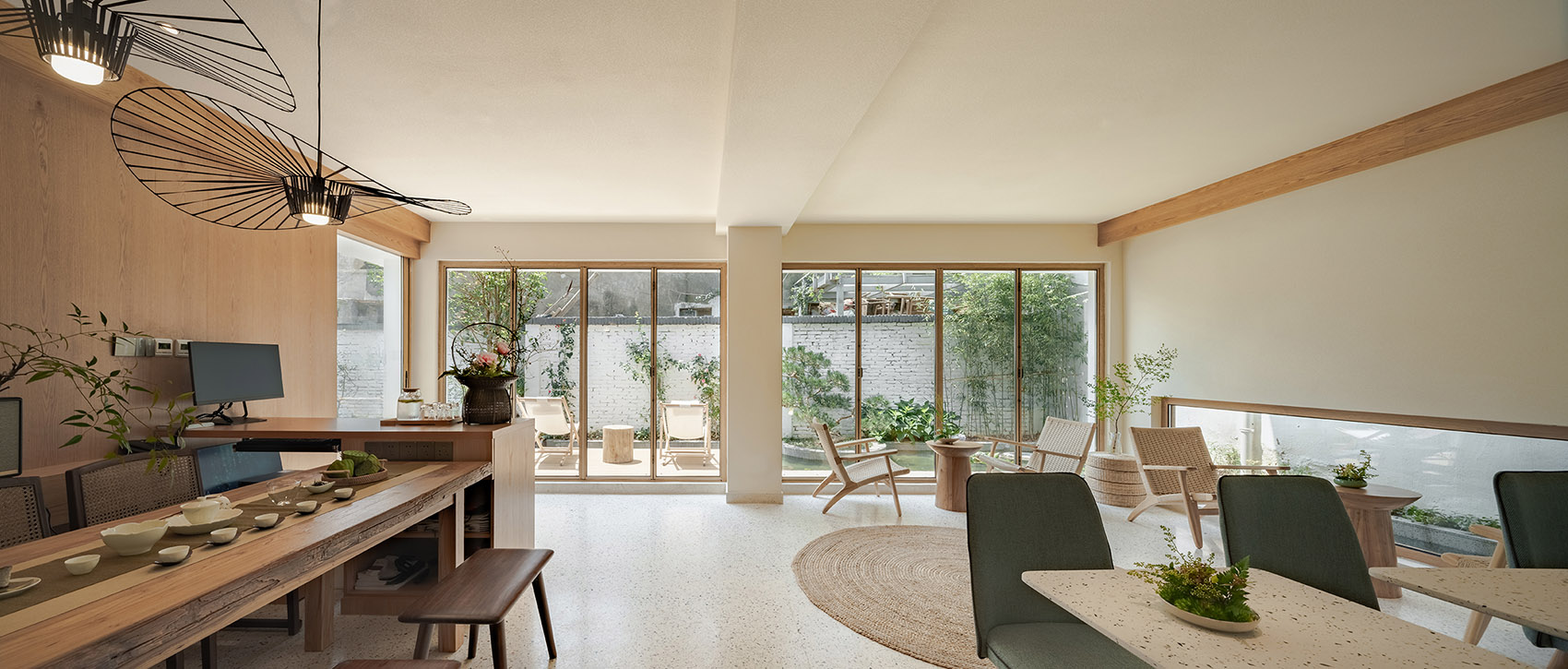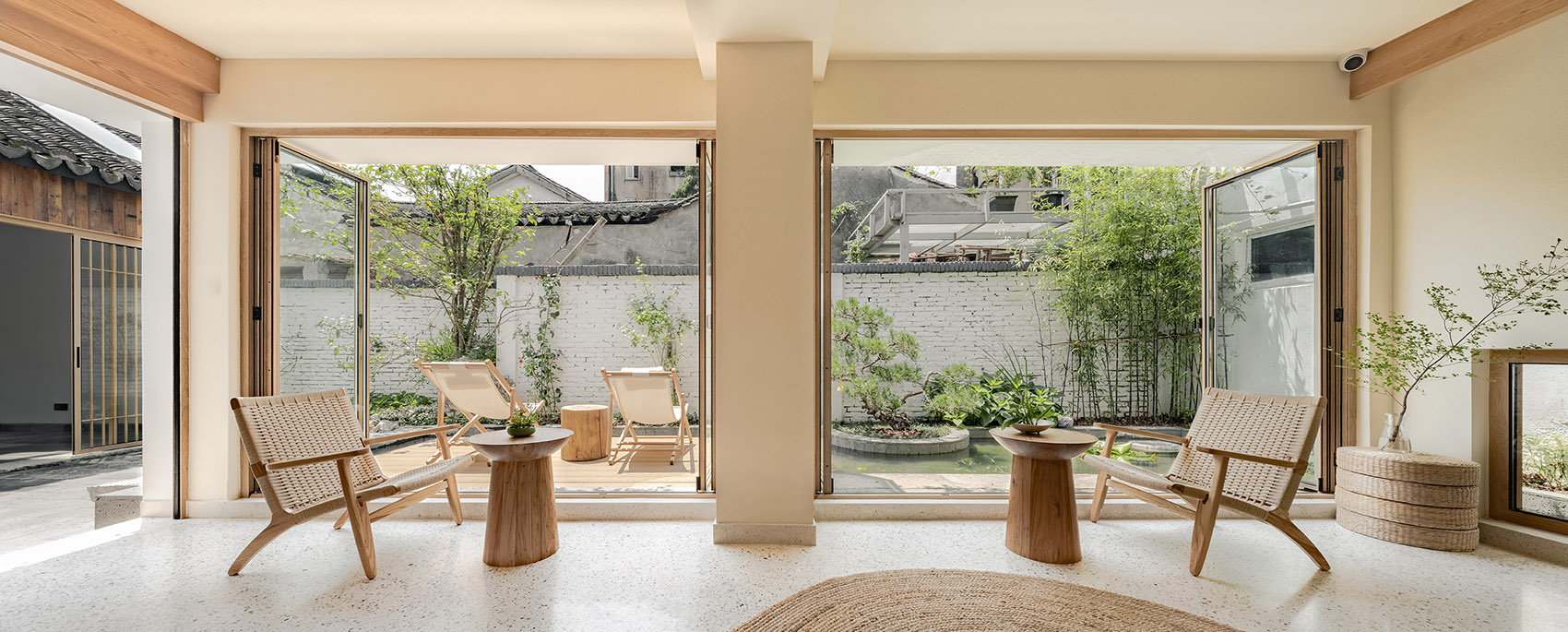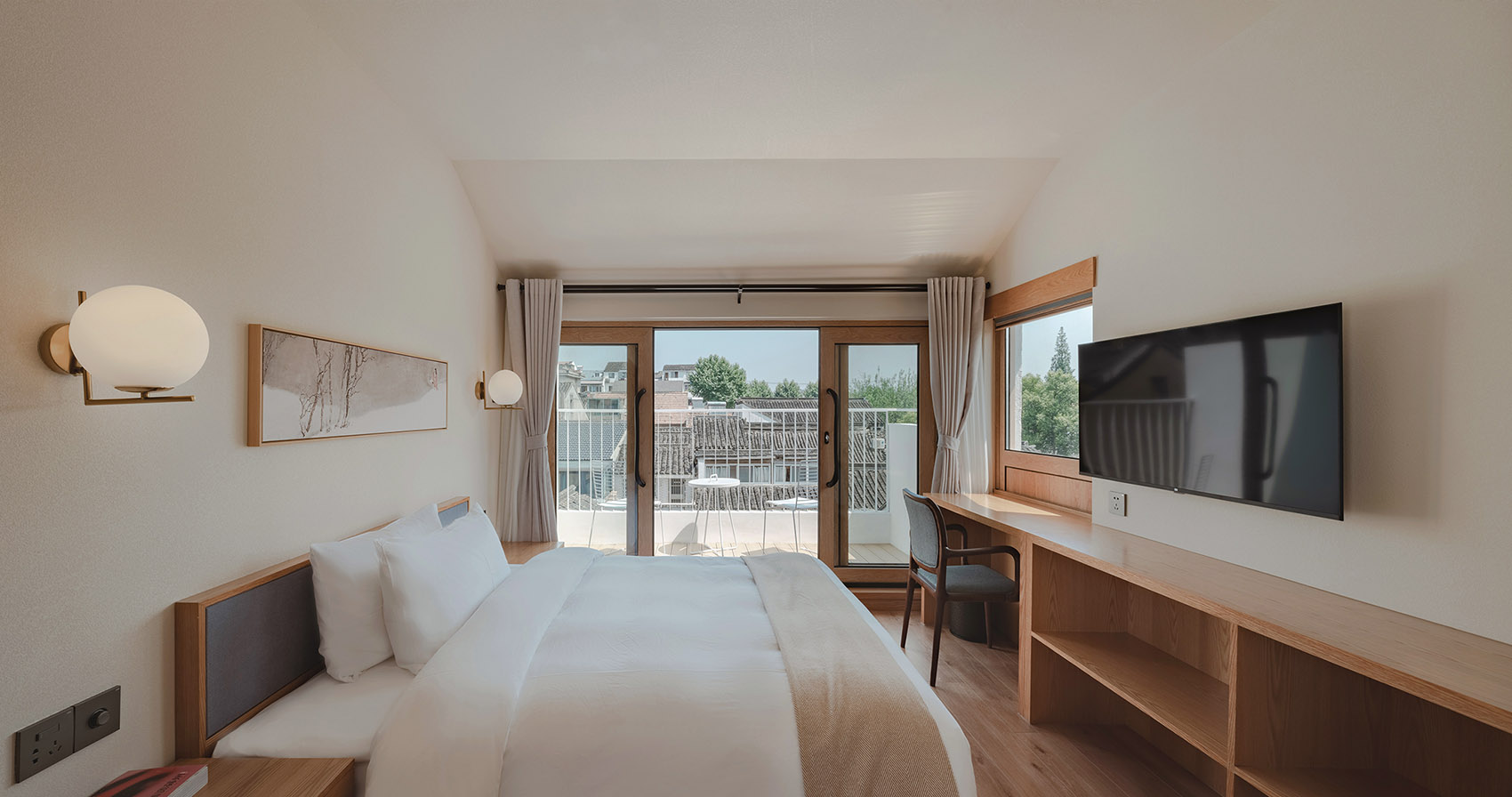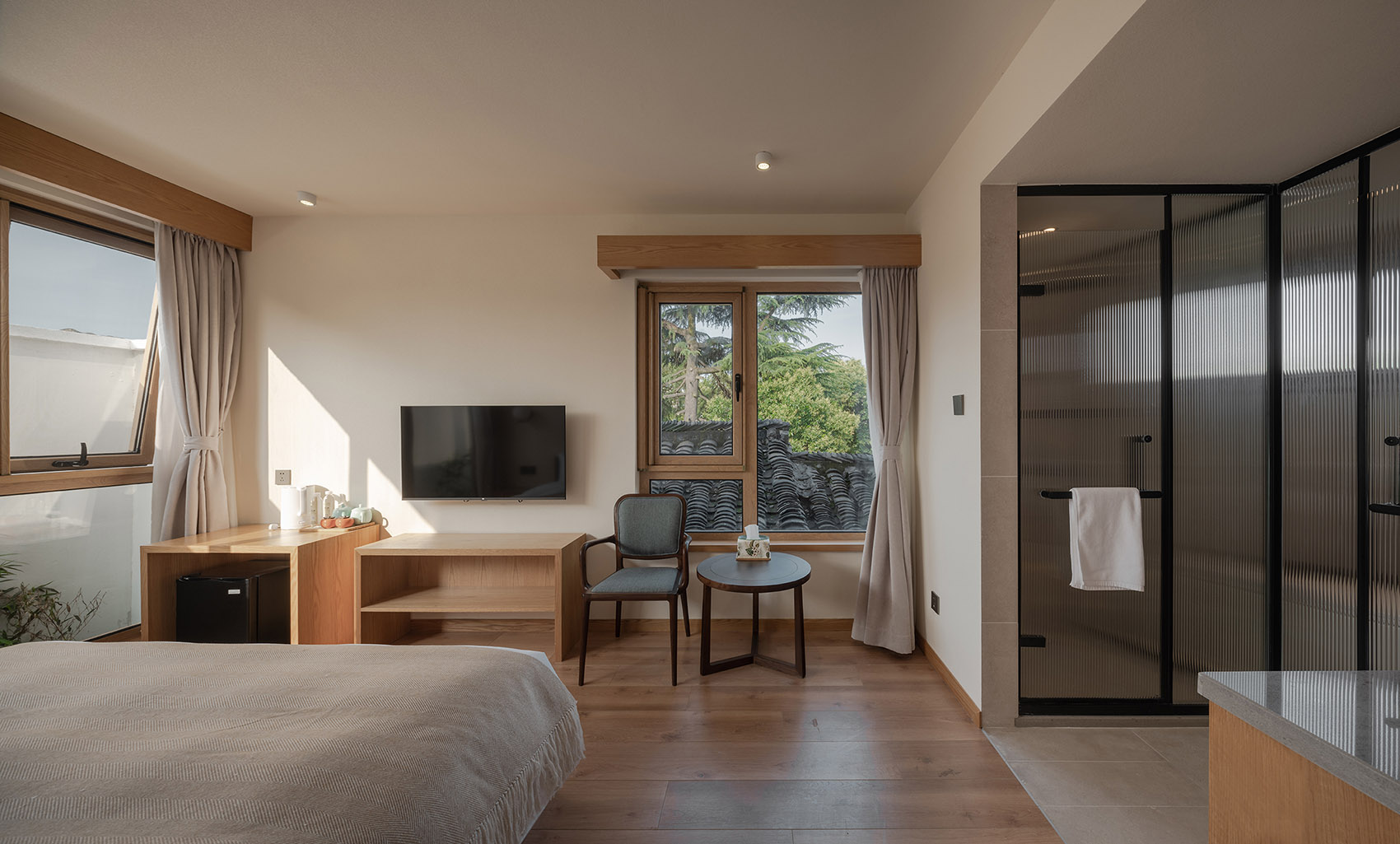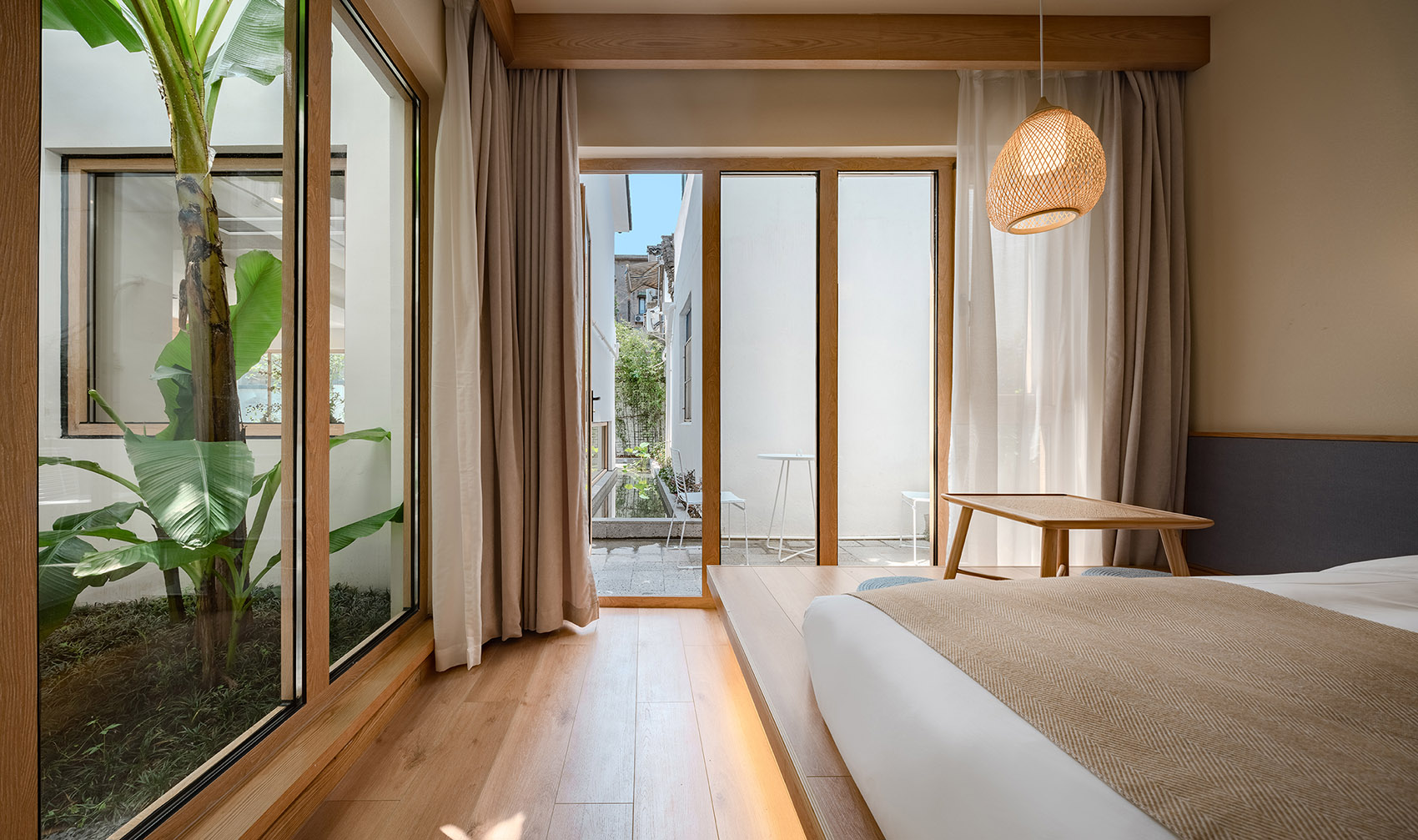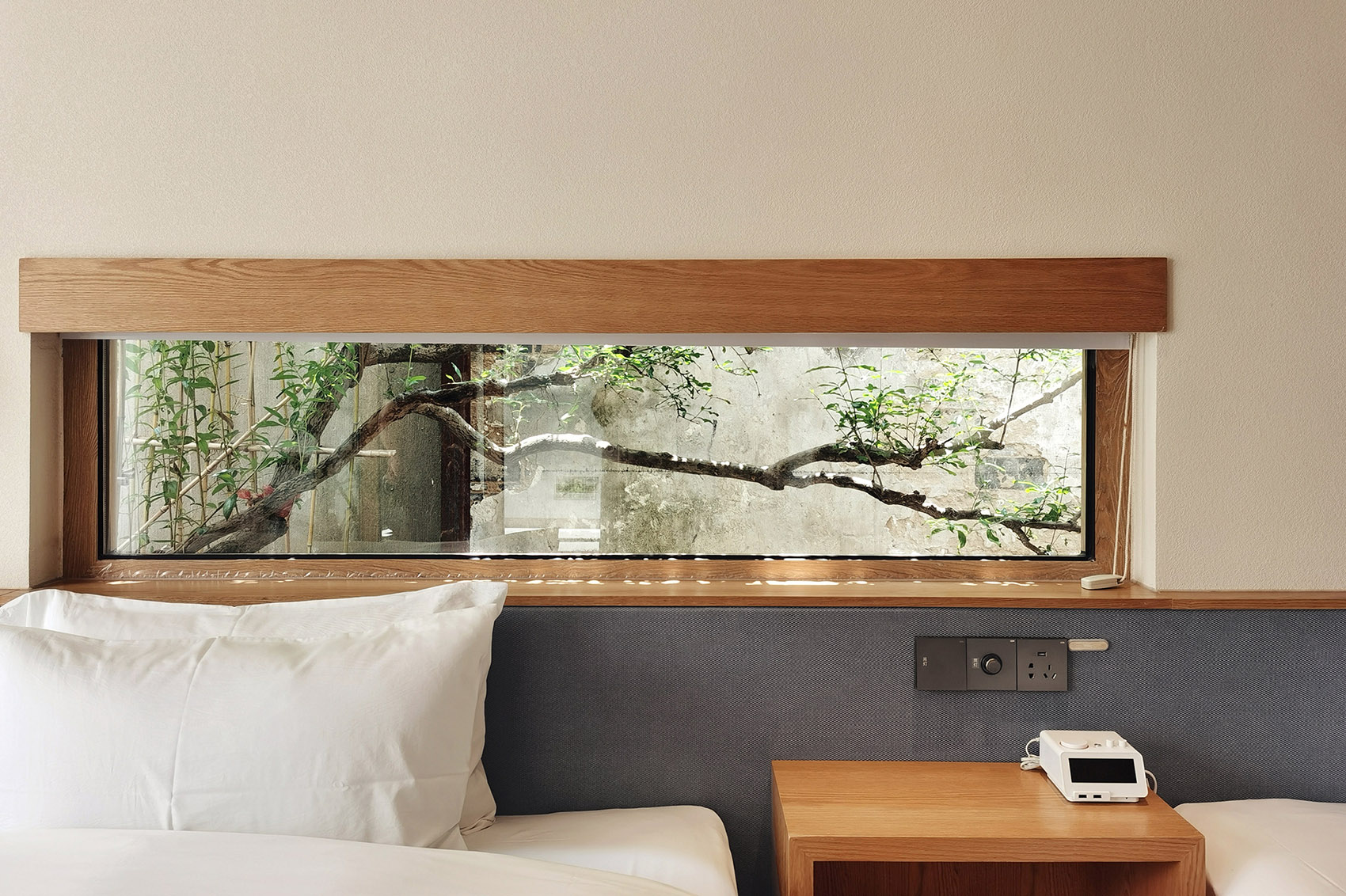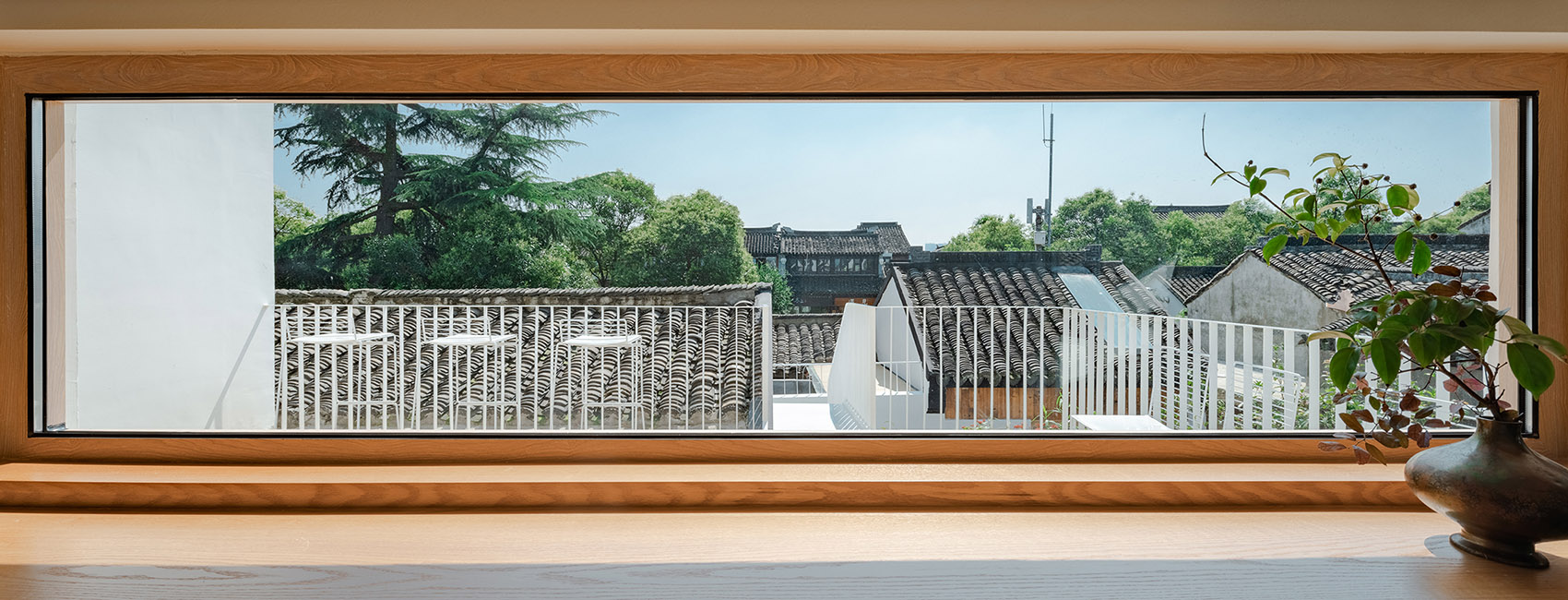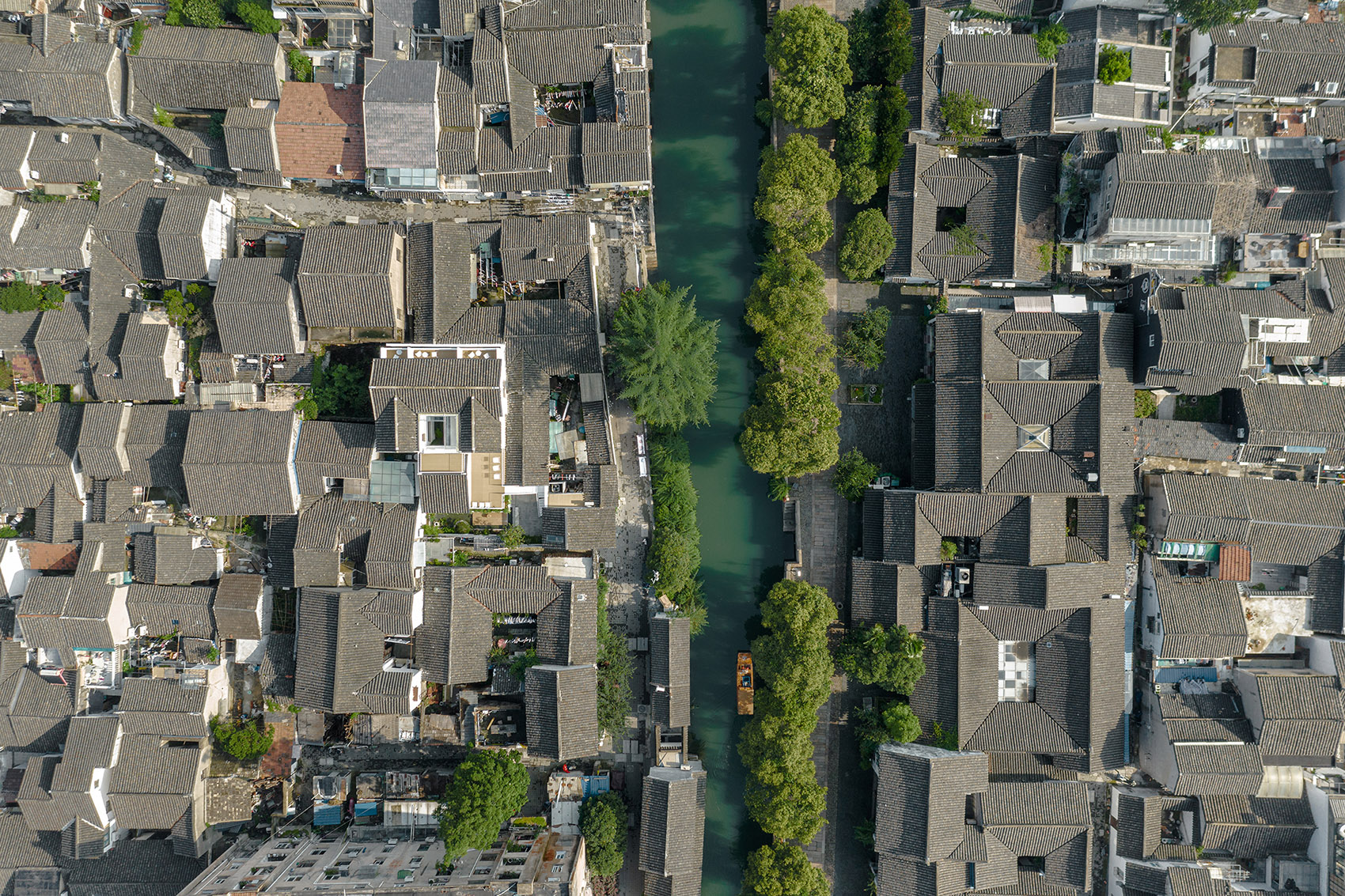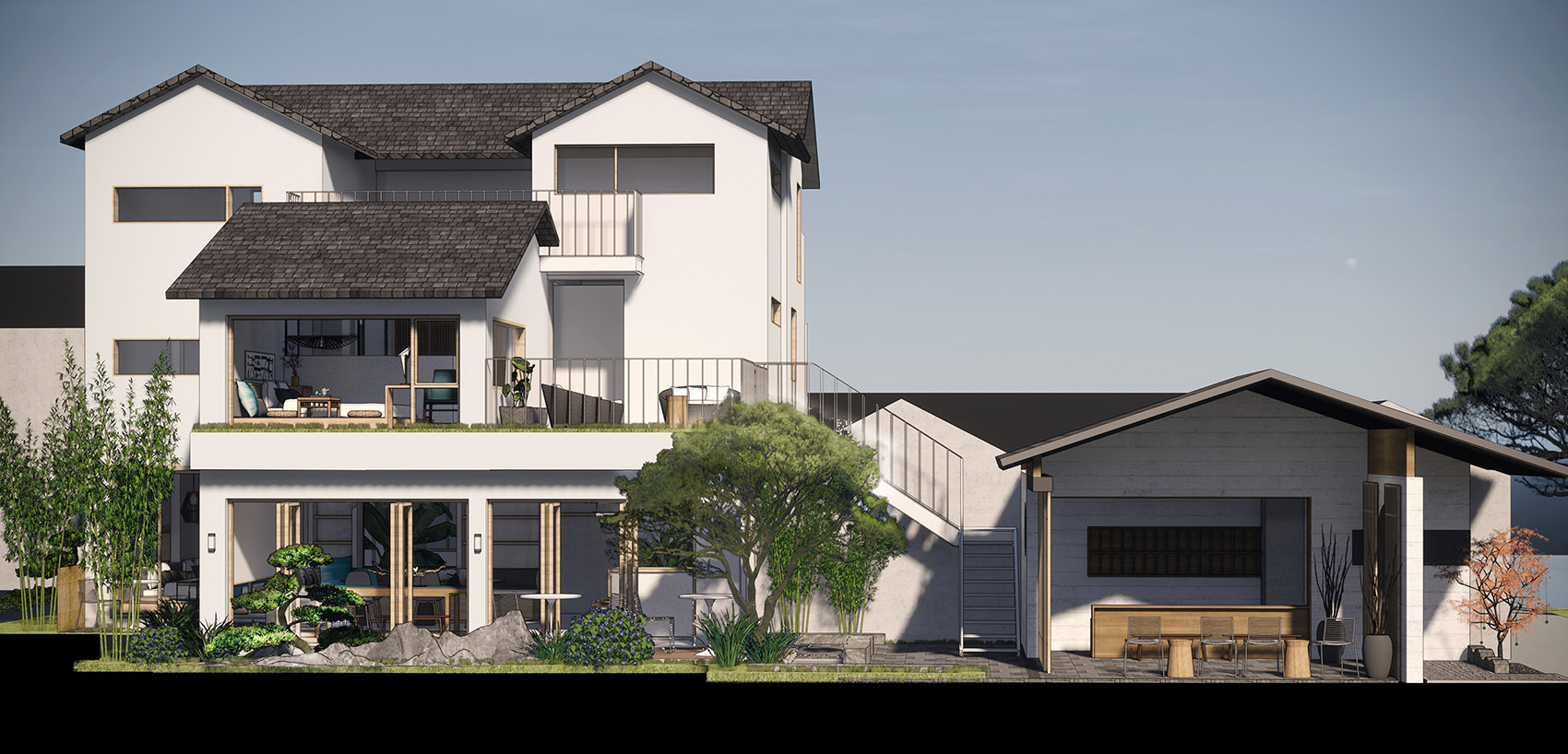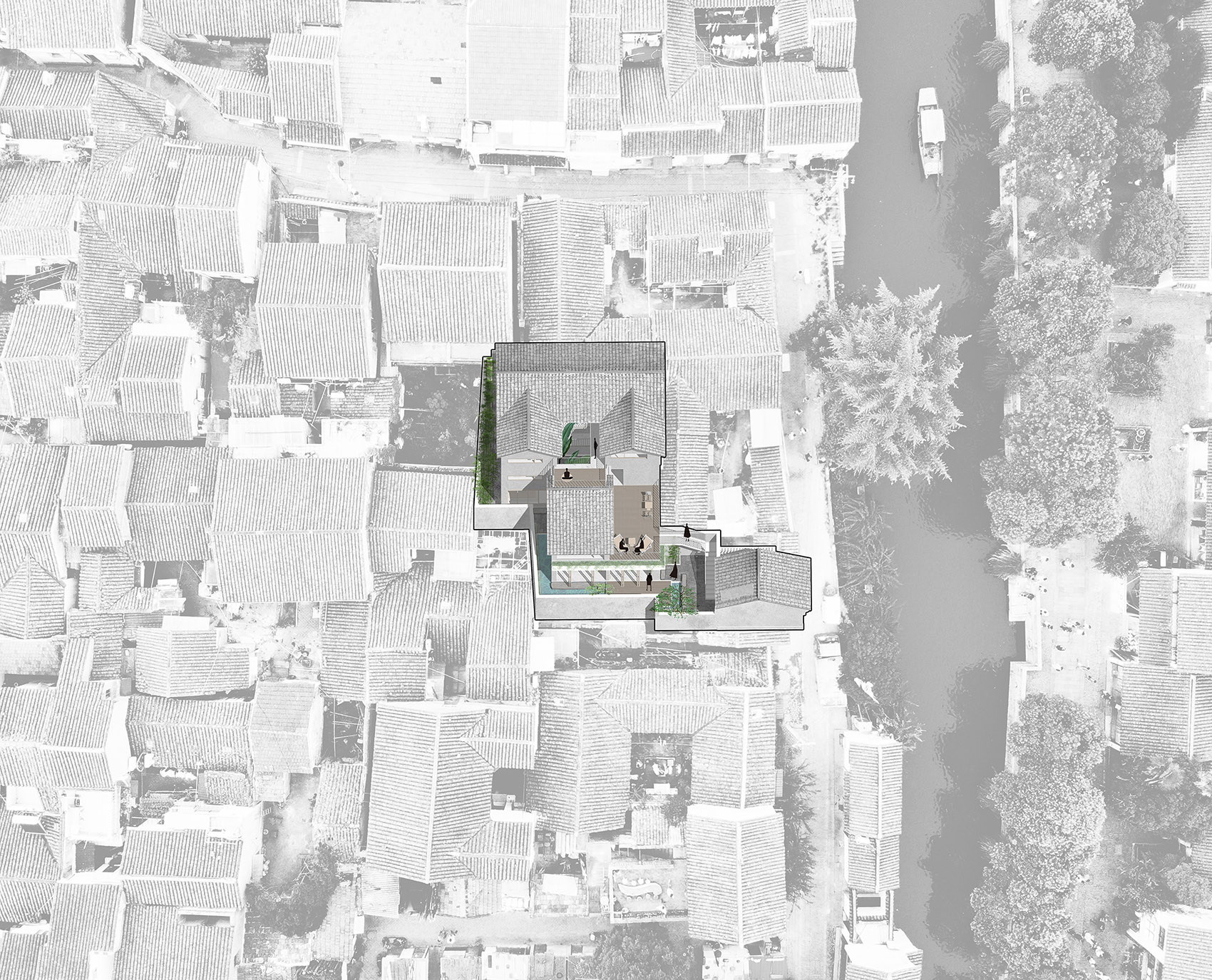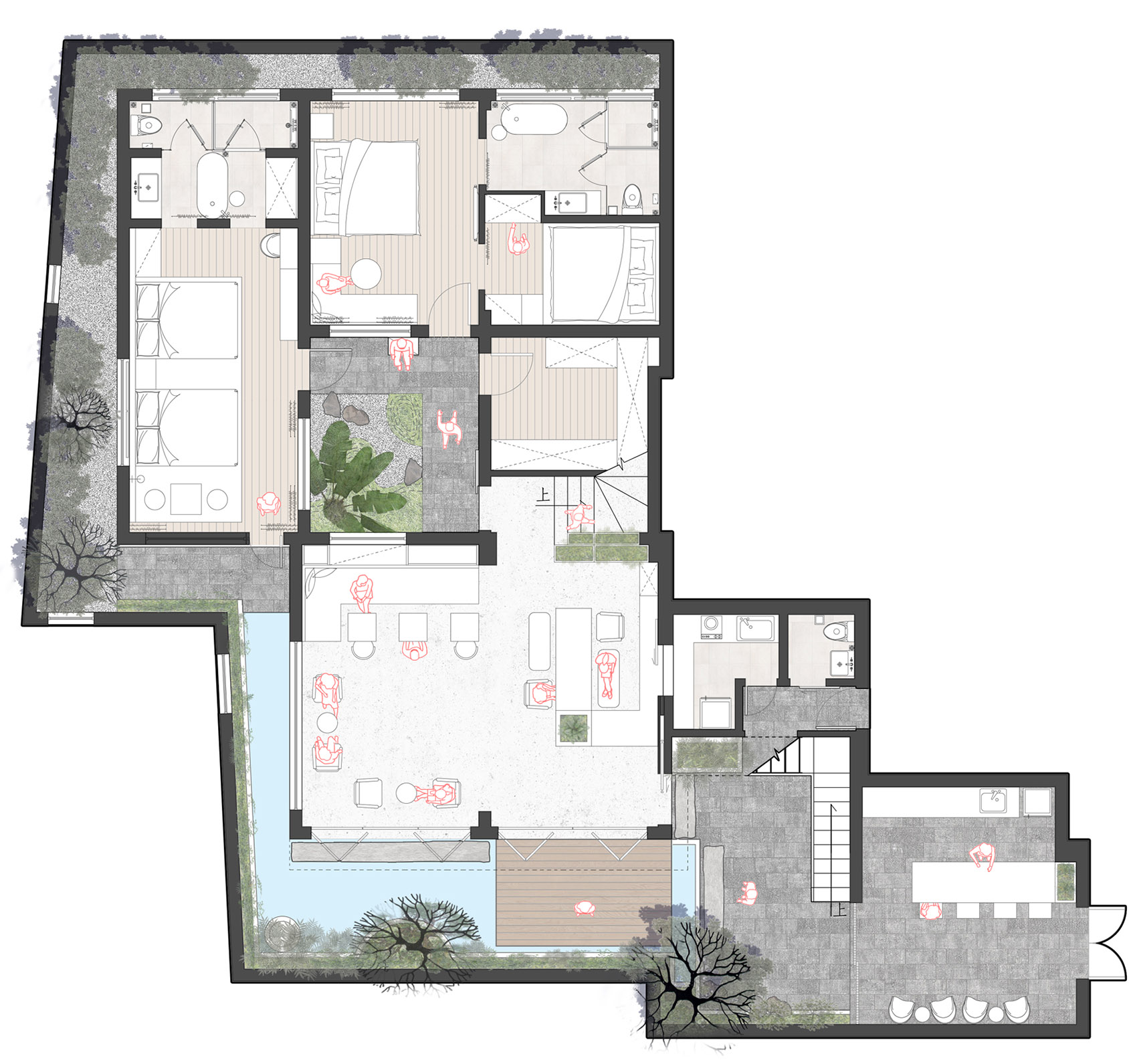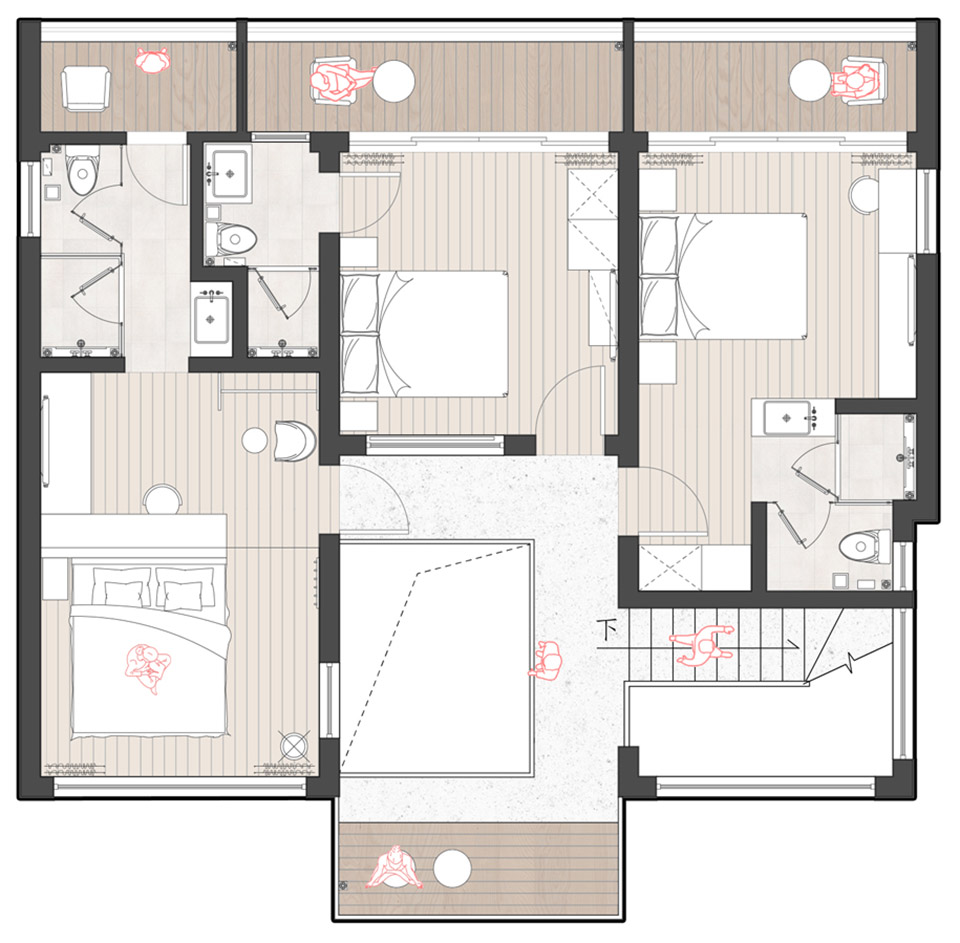项目位于苏州古城区平江路北段,东侧与主街临河相望,其他侧被周边民居围绕。除了东侧有较好视野外,其他界面并无优质外部景观资源,并且还要协调好项目和周边邻里的开窗、院墙、设备噪音等多种现实问题。业主希望在这块约260平的用地内,利用既有建筑的框架结构改造建设一个拥有10来间客房,并且有可外对经营的茶室、咖啡店等功能的微酒店。
The project sites at the corner of Donghua alley in the northern of Pingjiang Road, Suzhou’s most famous historical district. The east side facing the cannel of the main road with a good view of the cityscape, the other sides are surrounded by old residential buildings, facing walls and windows of neighborhoods. The owners proposed a micro-hotel with 10 rooms with functions like shared tea house or café by utilizing the structure of the existing building.
▼平江路南北向鸟瞰,aerial view along Pingjiang road ©Frank Lee
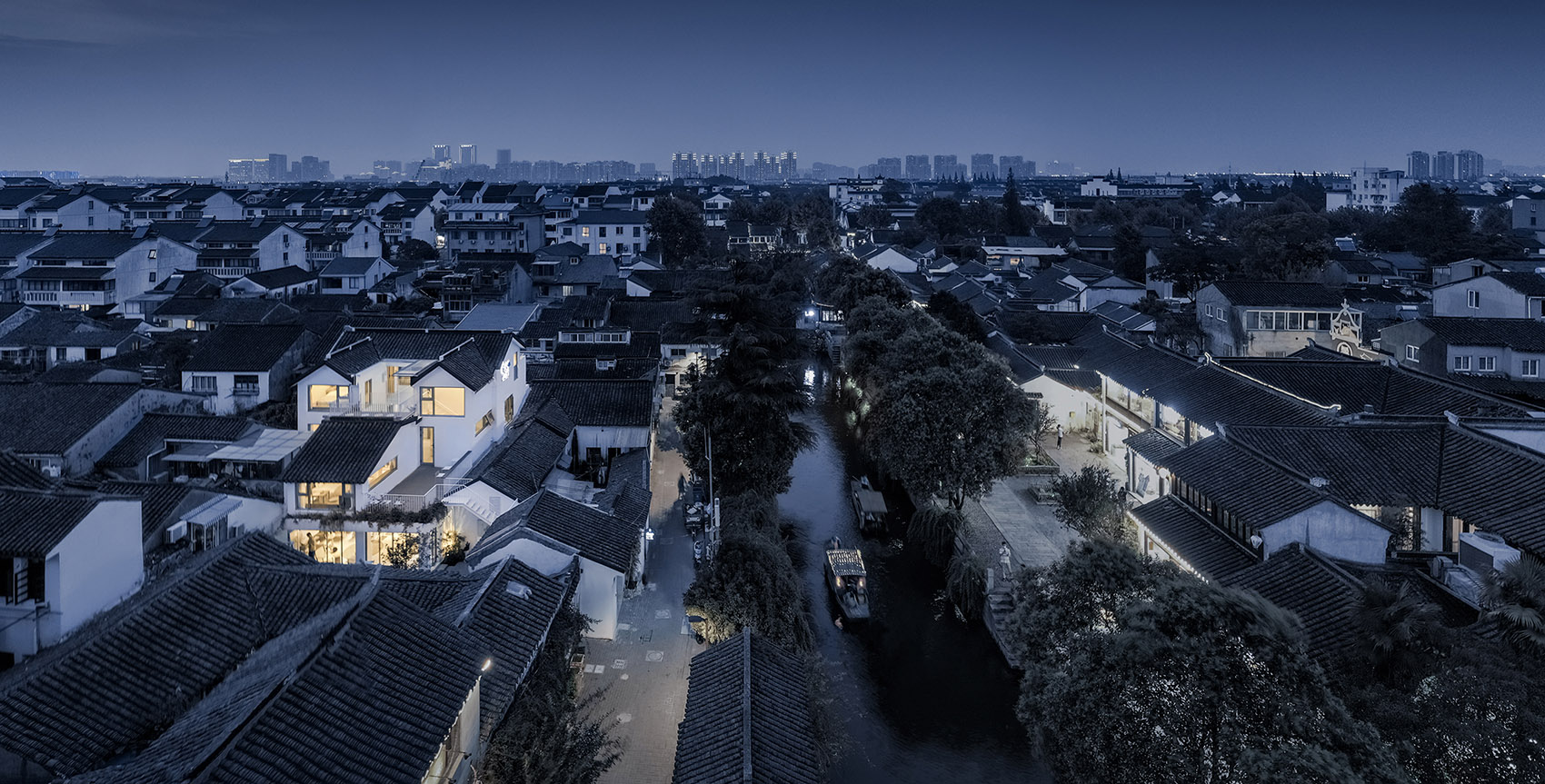
在相对拥挤的原有空间里,我们采用了“微园林,轻时尚”的设计原则,通过既有空间梳理出五个不同状态的小院子(前院,水院,中庭,边后院,露台院),使空间流动渗透,各个功能房间都有至少两面以上的景观面。步入其间,可以淋漓尽致的感受到四时光影,鱼戏莲叶,雨打芭蕉等精致恬淡的院景生活。
The idea of “micro garden, neo fashion” is adopted in this renovated old house. The presents of micro gardens (front yard, water courtyard, atrium, side backyard, terrace courtyard) allow the flowing of the space. Every room of the hotel has at least two different views of landscape. Here, weather and seasons could be experienced vividly, through the scenes setting in the gardens.
▼流动渗透院落示意,the flowing space between courtyard and interior ©Studio Ininches
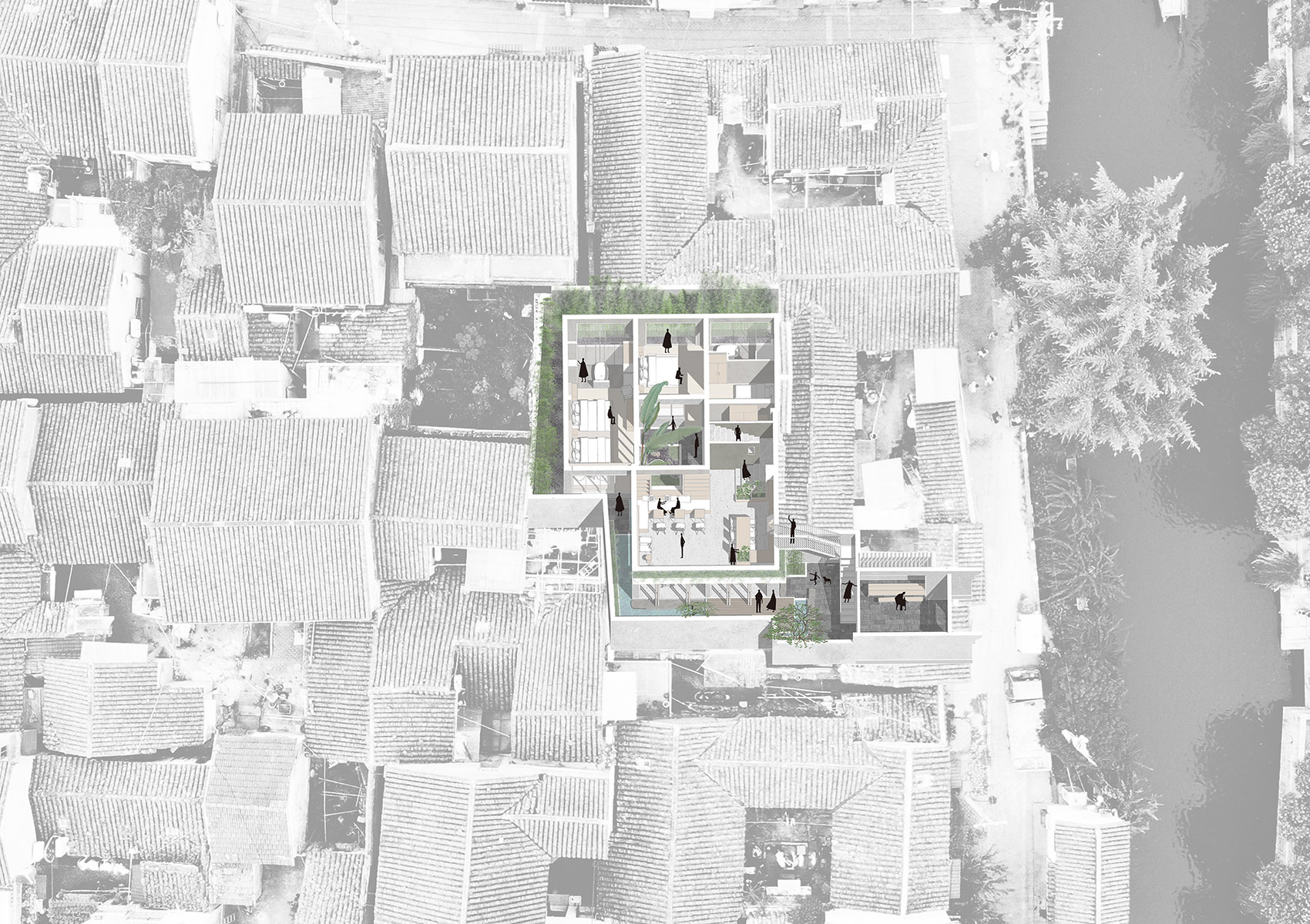
对于设计团队来说,也是希望在这个项目中,通过对既有建筑镶嵌院落灰空间的手法,唤醒场地的活力,激发出更大的空间价值,也是对古城历史街区众多微更新项目作出的一种积极尝试。
The design is to let the building itself step back, fading in the gardens, serving for circulation and different views, as to simulate traditional spatial quality of the area. It is also a positive attempt in case of micro-renovation in the historic district of this city.
▼西望古城,项目外观,external view of the project ©Frank Lee
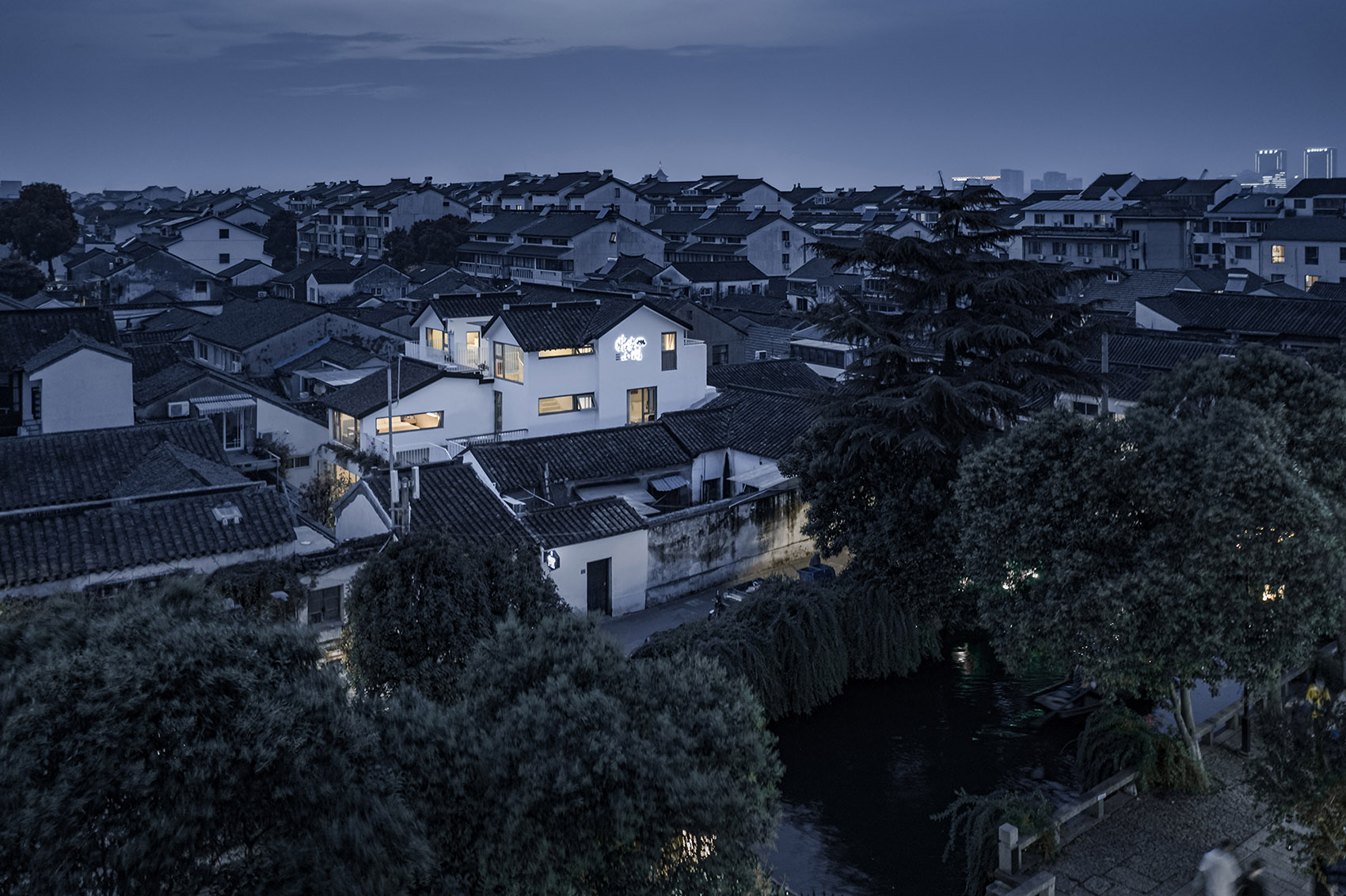
平江路上,通过一座老石桥沿着河边进入到场地的前厅,可以感受到前厅特殊处理的屋顶光线,达到一个短暂的停留和转换,同时透过格栅移门窥见内院的精彩。
Walking from an old stone bridge along the cannel to the front hall of the site, guests’ first encounter with the hotel is in the front hall. Here the space with lights filtered in through the skylight, casting dynamic shadows, welcomes the short stay. The inner courtyard could be glimpsed through the door grilles.
▼前厅光影,lights and shadows in the front hall ©Frank Lee
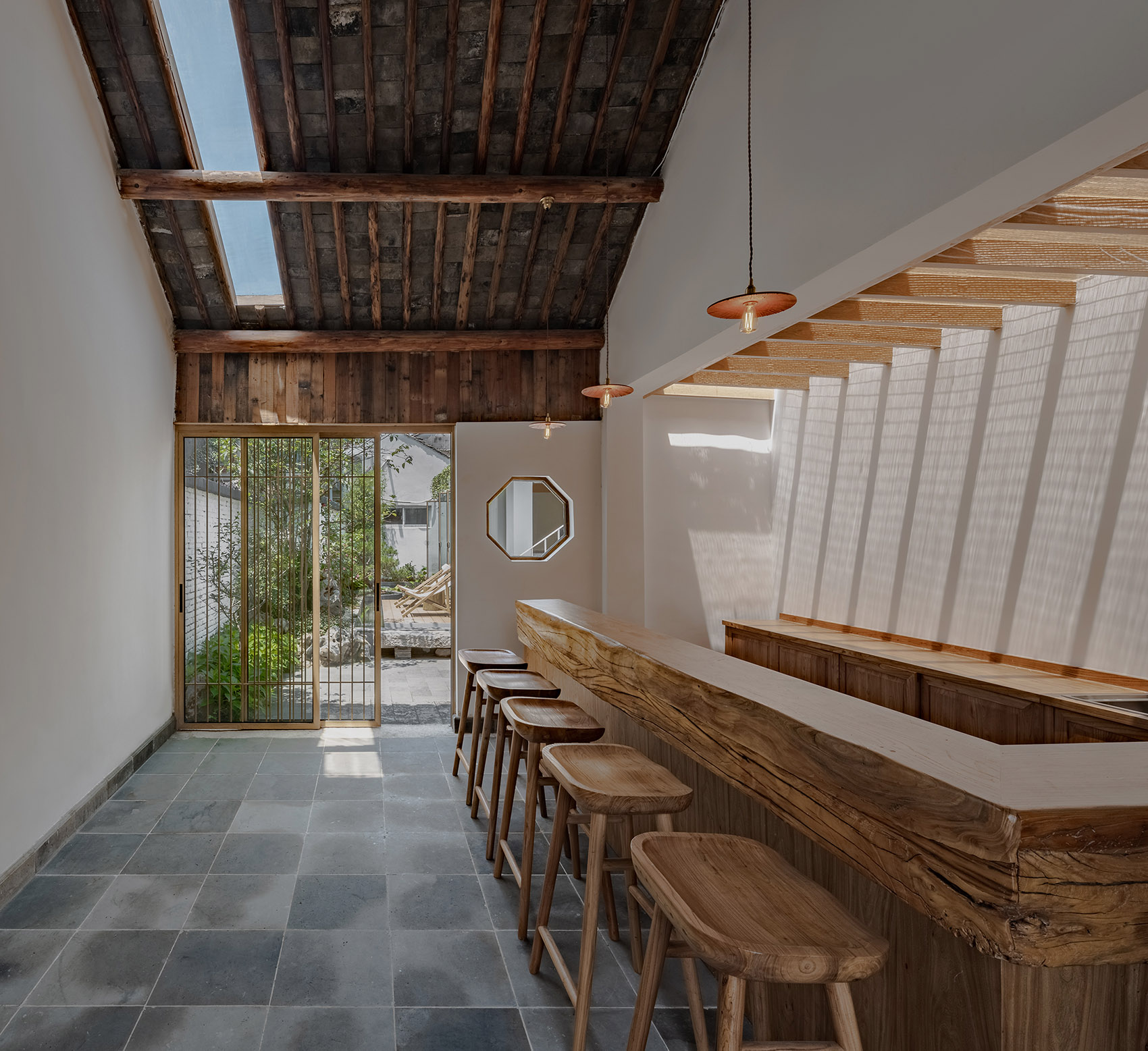
首层包括前院、水院、中庭,以及室内公区,体验到的是一个精致的带有苏州元素的时尚庭院,属于小型庭院尺度
The first floor includes the front yard, water courtyard, atrium, as well as indoor common area, with experience of some refined local elements in the space.
▼前院,front yard ©Frank Lee
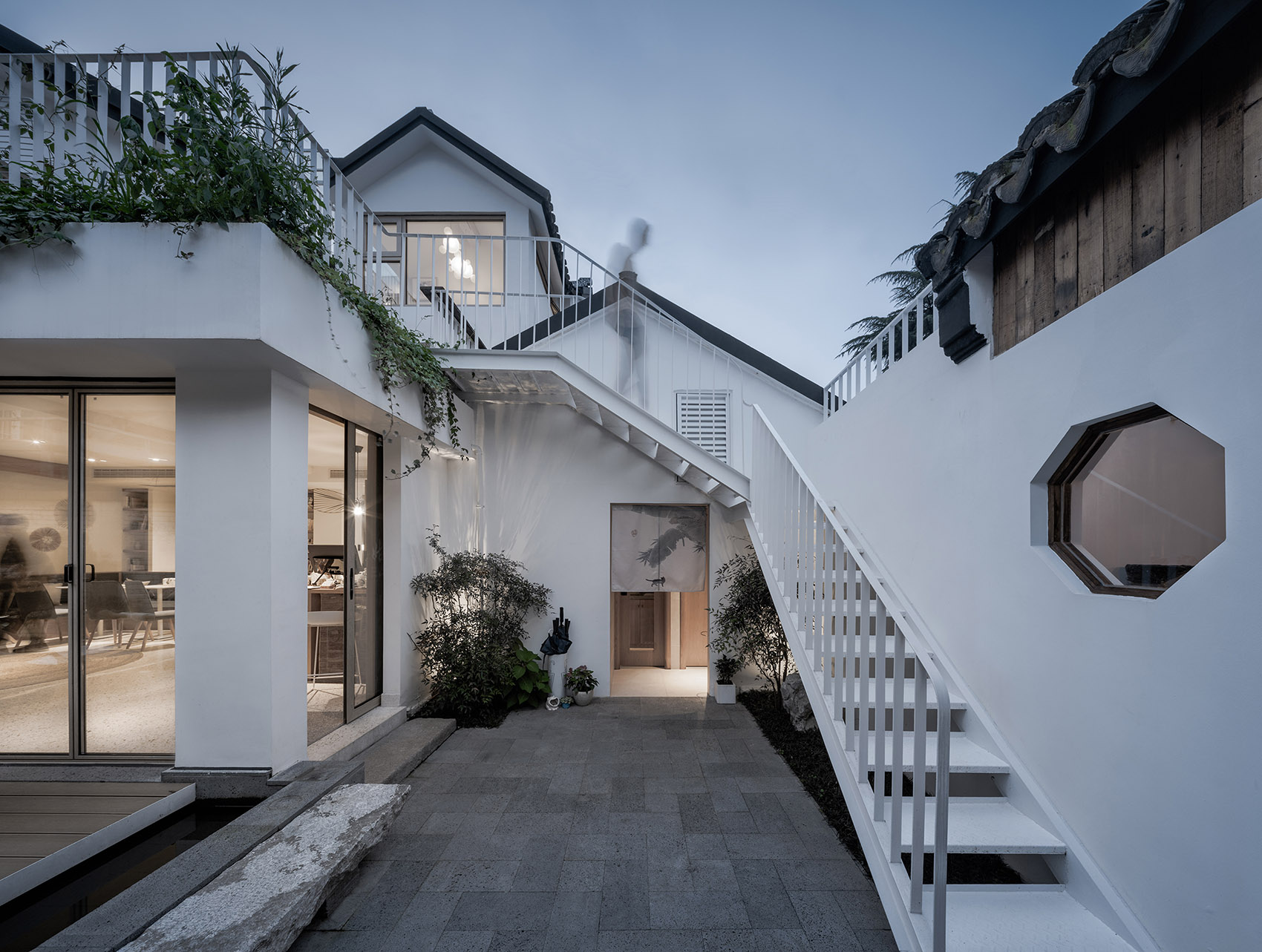
▼前院一角,a corner of the front yard ©Frank Lee
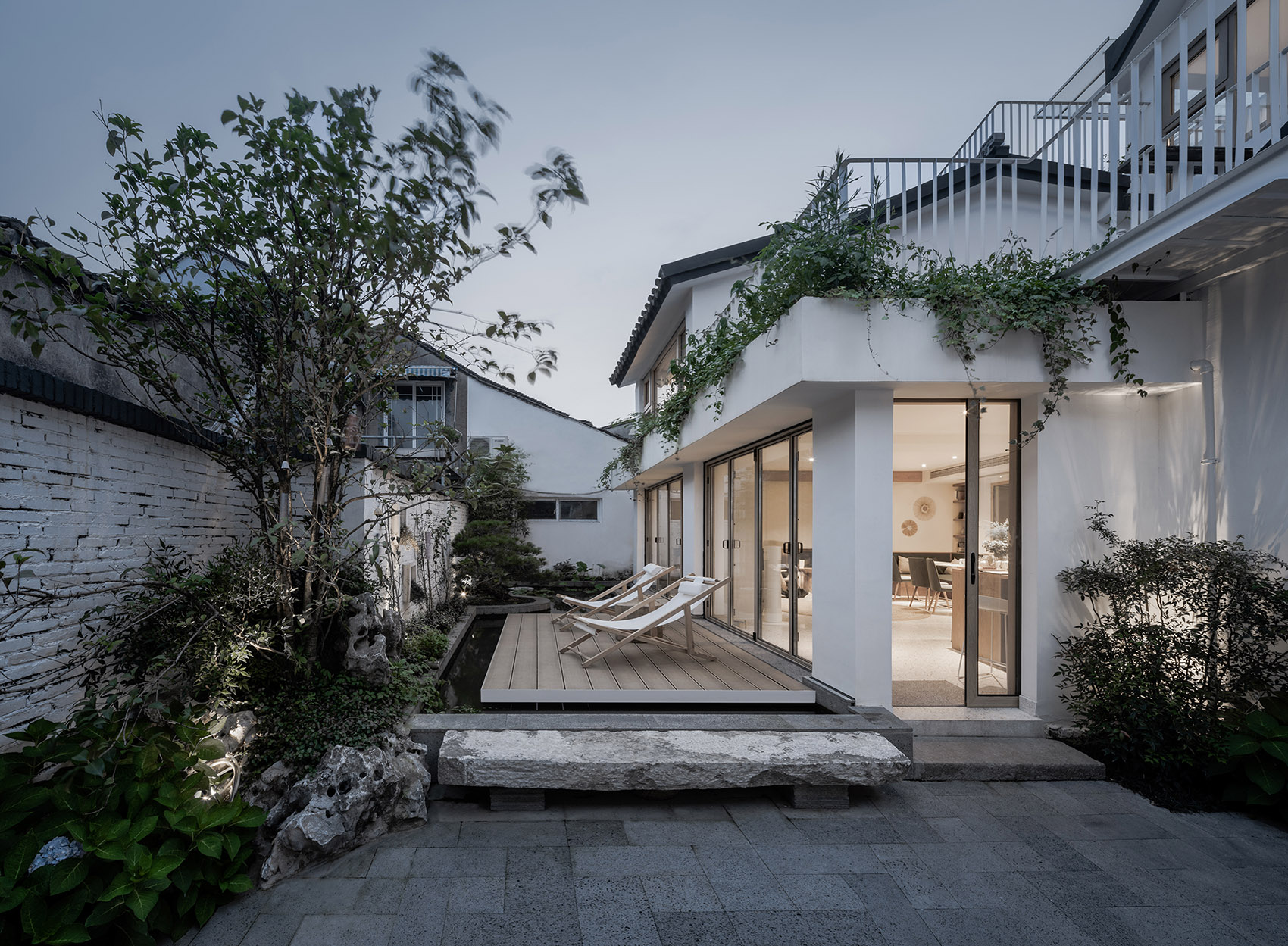
通过室外白色钢楼梯或者室内的水磨石楼梯上到二楼,透过室外平台或者房间里设置的东向取景窗,感受到的是平江路历史街区的老街尺度
Through the outdoor steel stair or indoor stone stairs up to the second floor, guests could reach the outdoor platform to get the view of street life of the historic district of Pingjiang Road, which is also framed as one visual composition of interior by the strip window of eastern guest room.
▼二层露台,感受老街风光,terrace on the second floor, enjoying the view of the historical street ©Frank Lee
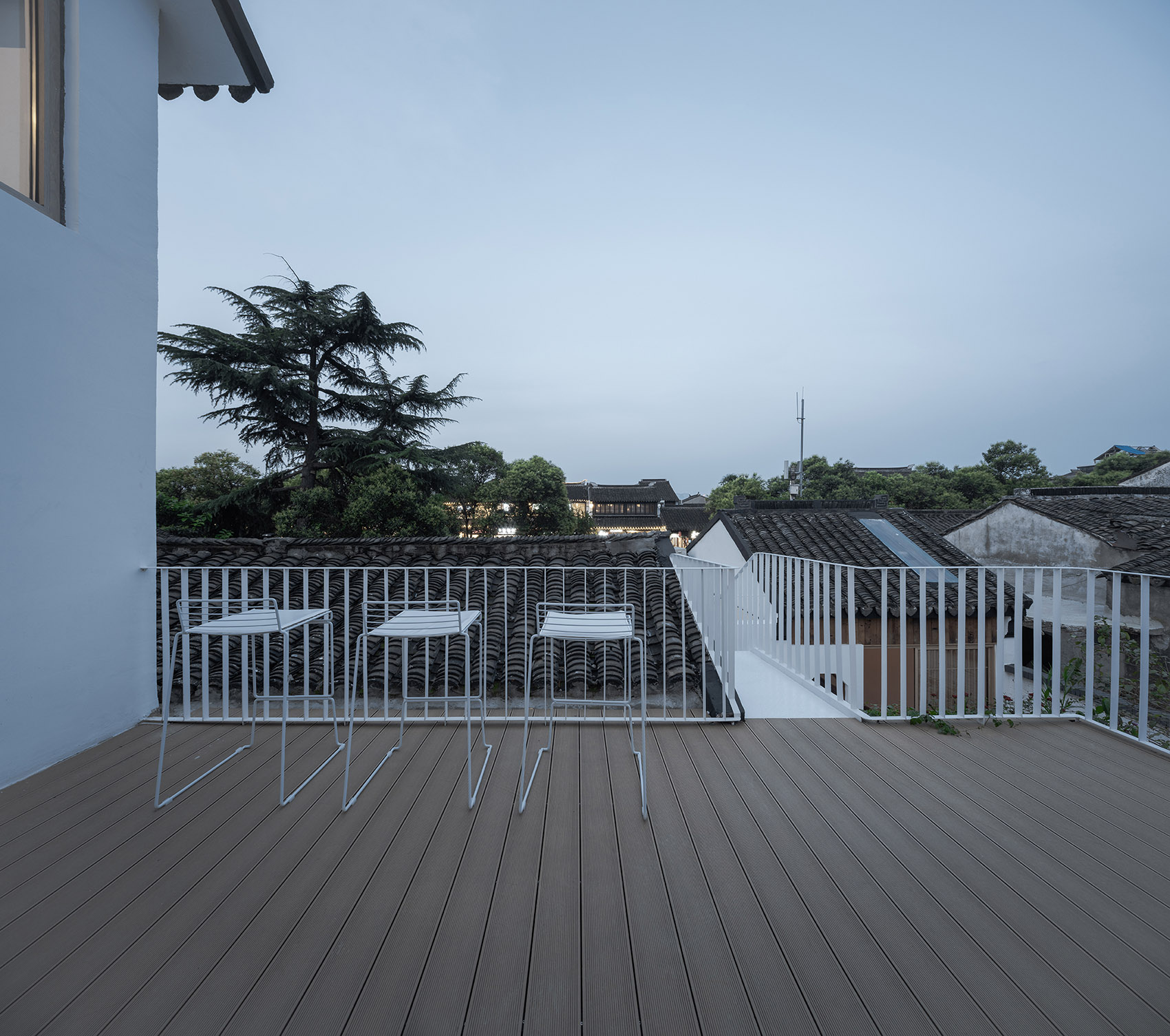
到了三楼的露台,远处苏州的新地标东方之门成为远眺的端景,同时透过近景的内部庭院,中景的古城老街天际线,共同形成一幅时空穿梭的生动画面
On the third-floor terrace, not only the near-by street life, the skyline of downtown area of Suzhou could be viewed. The “east gate”, A new landmark of Suzhou is clearly in sight if the weather is decent. Here the “old” foreground is merging with the “new” prospect.
▼三层露台远眺东方之门,the “east gate”, a new landmark of Suzhou is clearly in sight on the platform of 3rd floor ©Frank Lee

艺圃延光阁的启示,作为苏州本土设计师,艺圃是我们经常会去闲聊小坐的地方,那一方山水和屋面的波光粼粼早就习以为常。虽然现实条件相去甚远,但空间原型还是类似,因此通过折叠玻璃门,镜面水,院墙山石,以及挑檐空中绿化的处理来致敬艺圃的这处经典空间。
Which is inspired by one view in the famous local garden “Yipu” The Garden of Cultivation. The scene is in the Longevity Hall of “Yipu”, where the windows frame the view of lotus pond and landscape of rockery, the eaves reflects shining of the water. Drawing on this, we ties elements like folding glass doors, pond, rockery, plants and eaves here to give a dominant composition of the space.
▼剖面与边界取景窗示意,section and the diagram of different views framed by the windows ©Studio Ininches

▼大厅南向内景,interior view of the common room ©Frank Lee
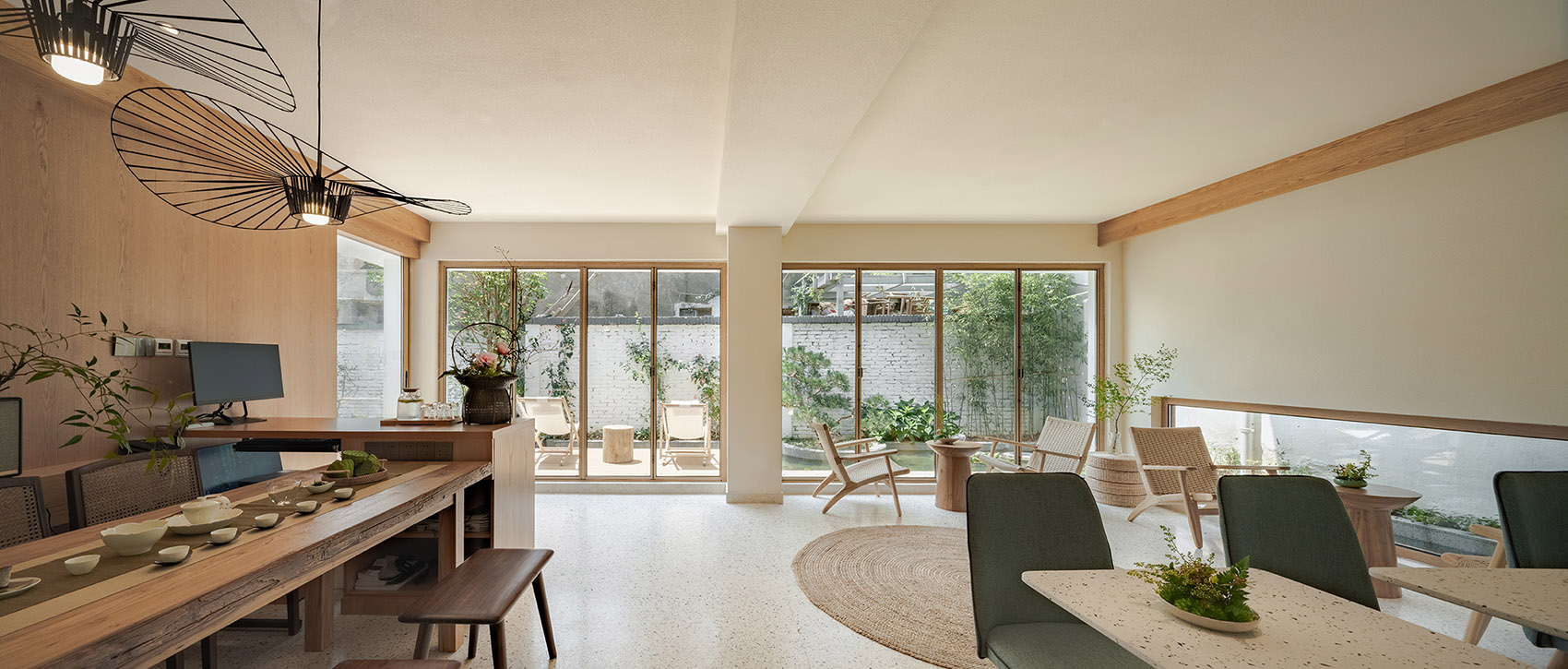
▼大厅与水院细节,detail of the common room and the water courtyard ©Frank Lee
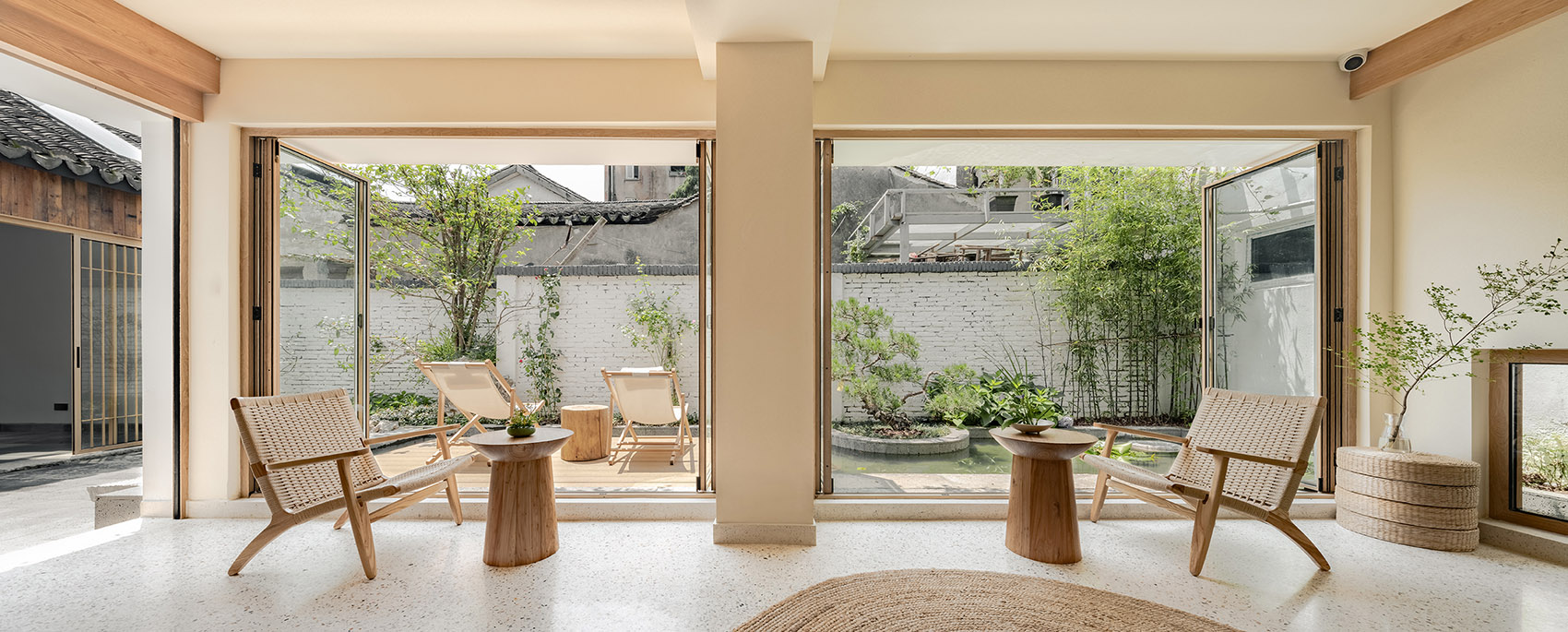
房子和周围邻居有很多相连的部分,邻居厨房的开窗正对着公区大厅,于是就设置地面窗取景,同时兼顾邻居的需求。北侧对着杂乱的相邻屋顶,于是另外单独起了一道院墙,形成了一个北侧狭长的种满竹子的室外空间,补充了一楼房间的采光,阻隔了二楼北侧的不良视野,框定了一个相对整齐的古城天际线视野。西侧对着隔壁荒废的老宅院子,就利用斑驳的老院墙作为背景,设置取景窗和主景石榴树,形成局部小景。
The windows of the neighbor’s kitchen are facing the common hall, so a lower window is set up to take the view. The north side is facing cluttered roofs. Here a courtyard wall is up to block the view of mess, framed a relatively neat view of the old city, also encloses a narrow outdoor space to plant bamboo. The west side faces the yard of an abandoned house. The mottled wall of the house is taken as the background of a pomegranate tree, setts a frame of view for the interior.
▼中庭芭蕉,the plantain in the atrium ©Frank Lee
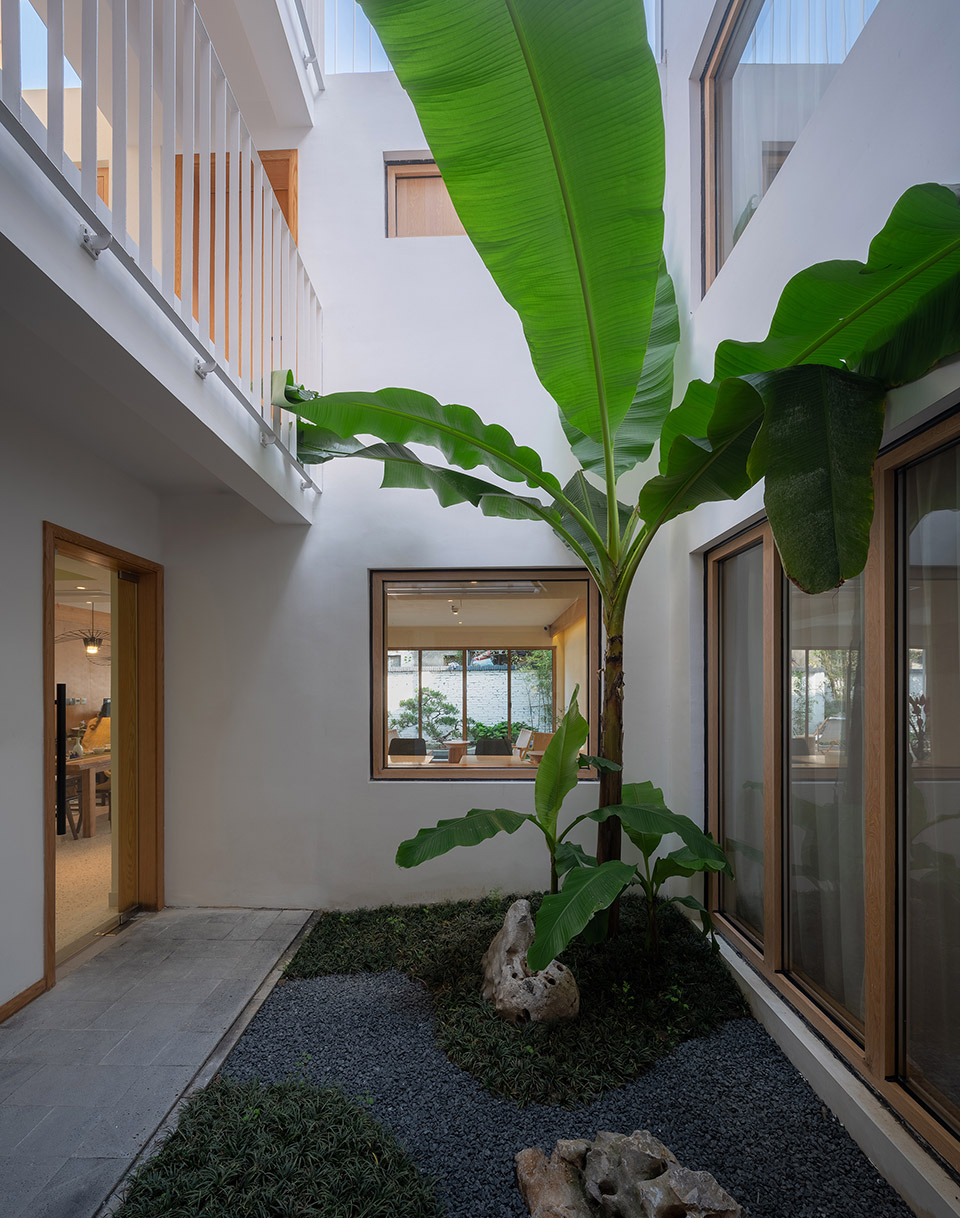
▼二楼中庭,atrium on the second floor ©马道长
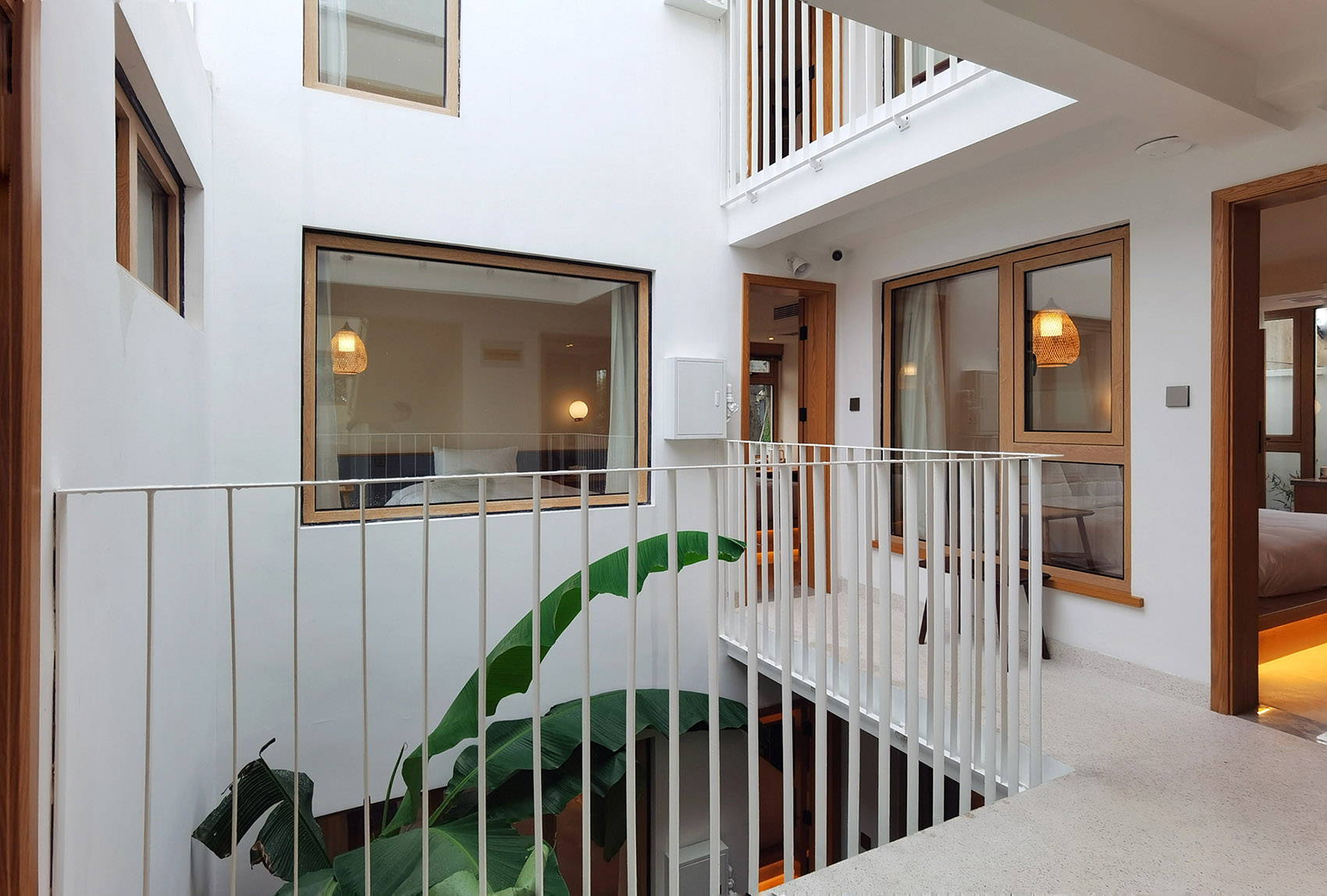
▼一楼西侧庭院房,the guest room with western courtyard on 1st floor ©Frank Lee
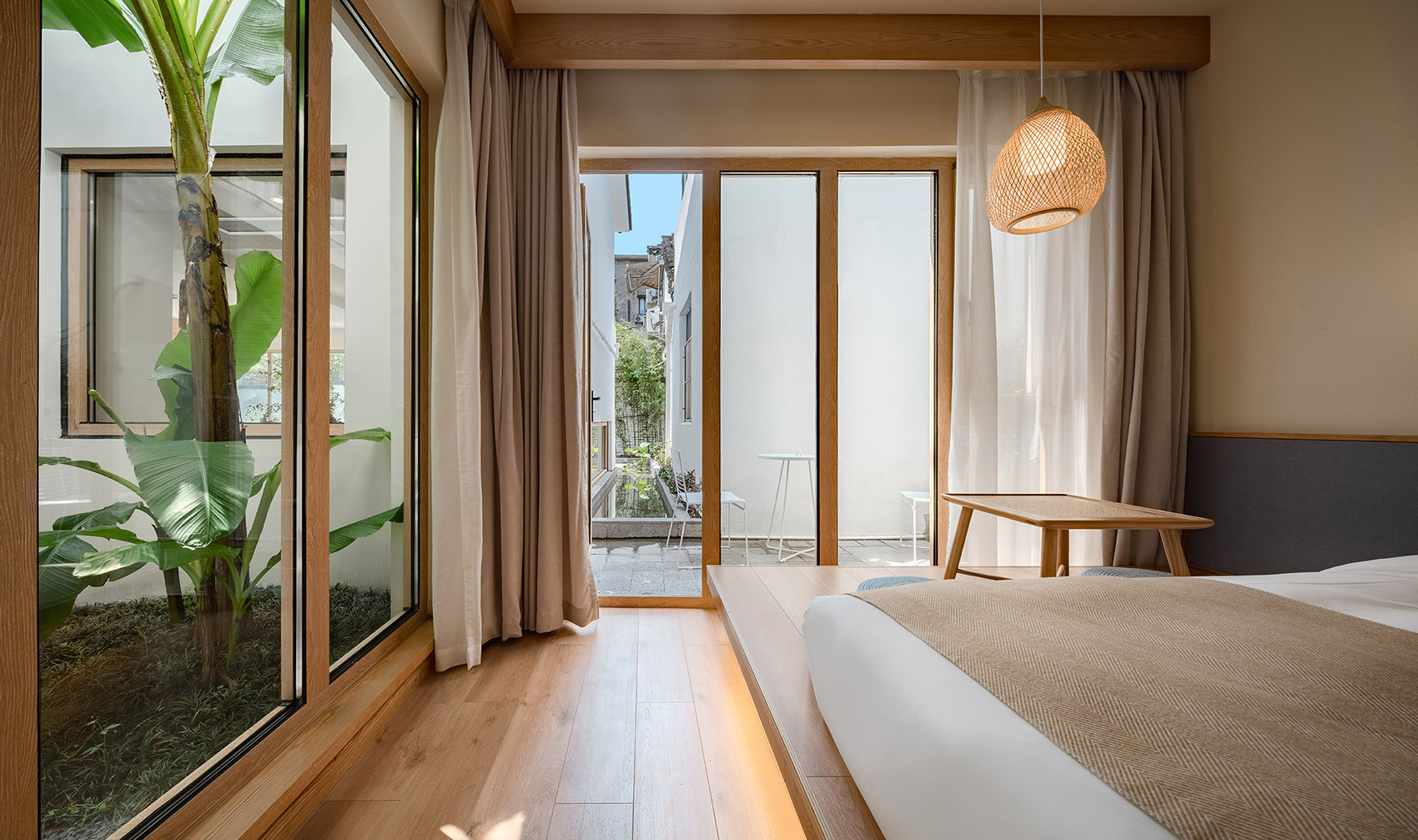
▼二楼东侧街景房间,the guest room with eastern view of the street on 2nd floor ©Frank Lee

▼三楼中间庭院房间,the middle guest room facing the courtyard on 3rd floor ©Frank Lee
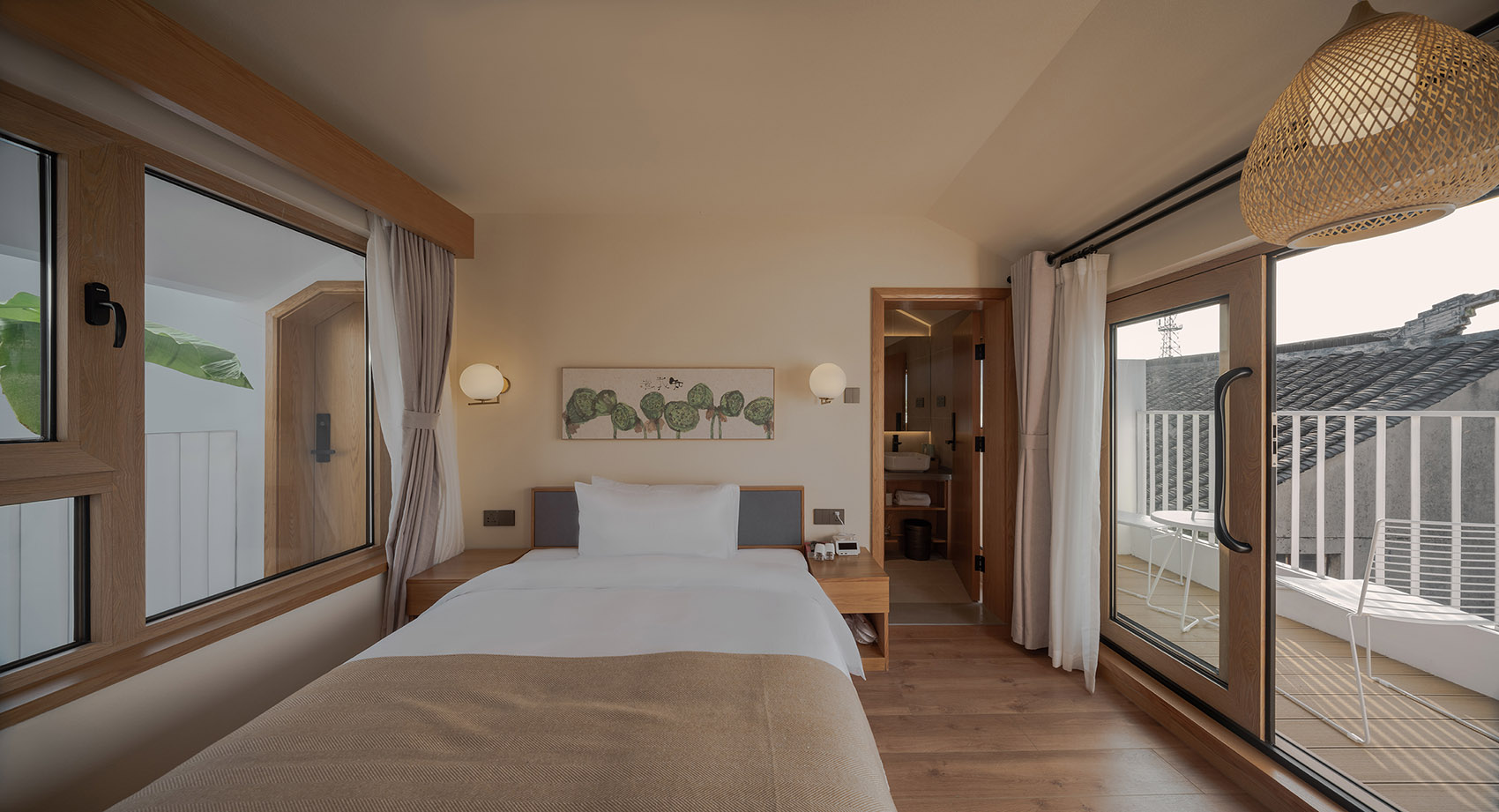
▼三楼东侧街景房间,the guest room with eastern view of the street on 3rd floor ©Frank Lee
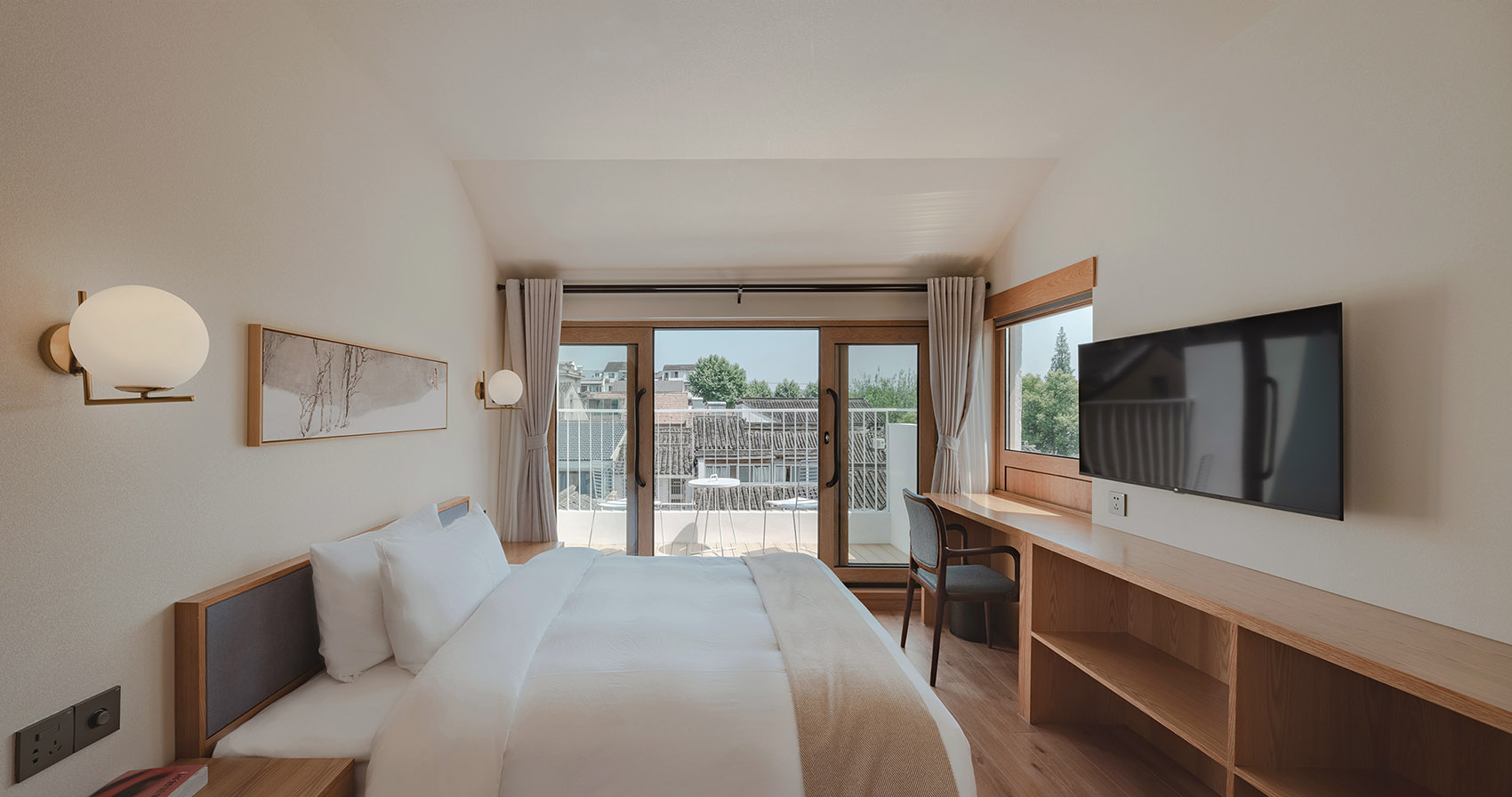
此次设计更多的是对存量建筑空间的改造提升,而且因为地处历史街区核心地段,受古城保护和周边邻里的影响,对于建筑学而言的建构、材料表达相对受限。这也是在苏州古城做相关设计的一个常态,但通过空间体验感提升场所价值这一普遍诉求不应该因此受限。
The design of this project takes a humble approach. For the site locating in the core area of historic heritage protection, the material and structural expression of building itself is limited. It is one common situation to do design works here in the old city of Suzhou. Therefore, our strategy is more about “amplifying” the atmosphere of vernacular courtyard house and gardens by setting daily/seasonal scenes to experience.
▼西侧水院荷花,lotus of the western water courtyard ©马道长
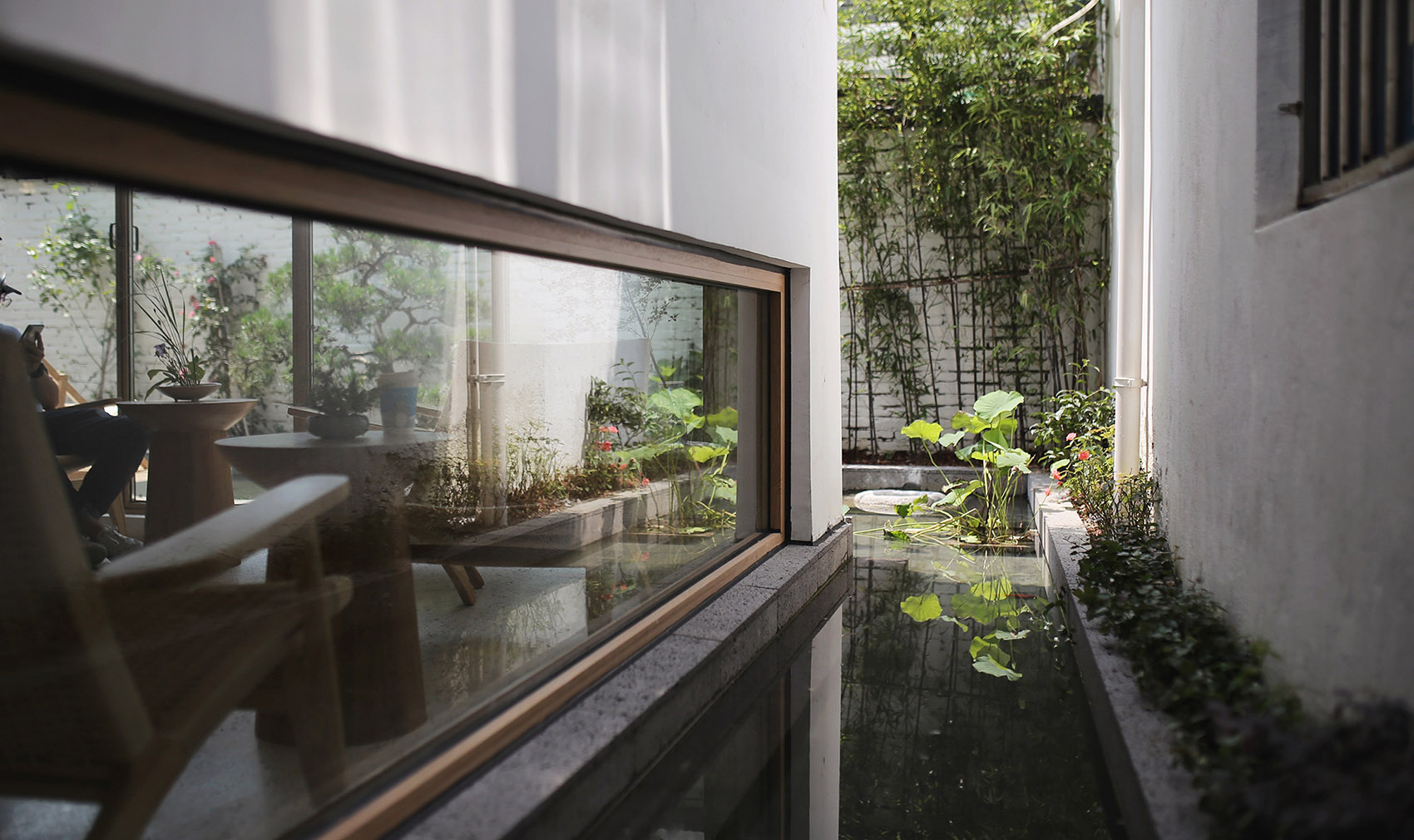
▼老院墙与石榴树,the old wall and the pomegranate tree ©马道长
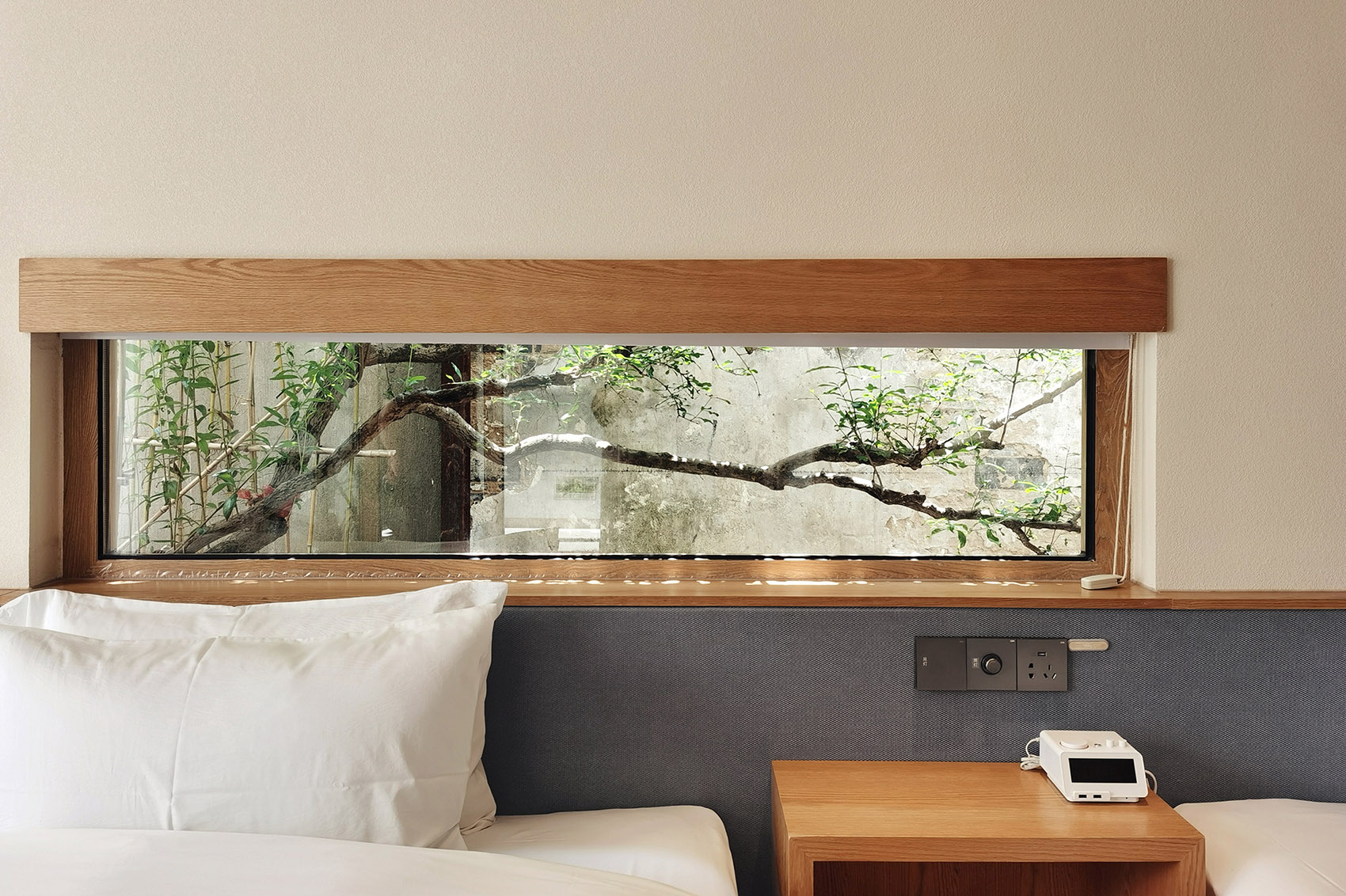
▼露台房间窗景,view from the window of the guest room near the platform ©Frank Lee
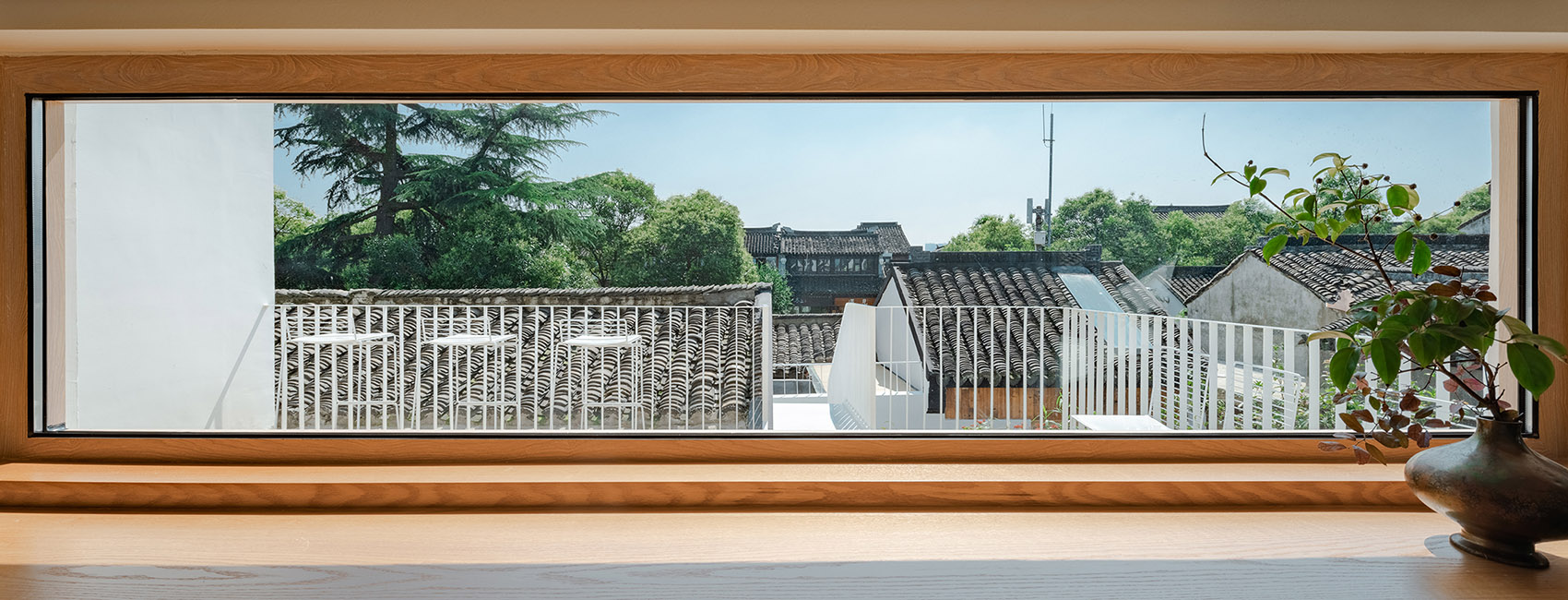
我们通过若干个微庭院的设置引导,让空间流动,让光线穿梭渗透进原本闭塞的空间内,让水、石、木、绿这些基础自然元素自由弥漫在空间各处,配合一些自然温润的装饰材料,如木饰面、水磨石、硅藻泥等作为背景,来共同激发出场所的温度感和活力感。客观条件让这个项目不太能有建筑的自我表达,也让我们更多的是通过内省的方式来充分设计和挖掘内部空间的精彩可能性。这也是我们的设计哲学:建筑的本质是一处让人放松平静的空间,控制建筑和建筑师自我表达的声音,让建筑空间更安静的去服务人和环境,成为一个温暖的容器。
The micro gardens contain natural dynamic elements: water, plants, rockery…which act passively with the weather, daylights and the circulation of the users, which provide continual delightfulness for the space. The more “artificial” interior, with material like wood, terrazzo, diatom mud…is also trying to mimic the experience of the gardens.
▼一层平面图,first floor plan ©Studio Ininches
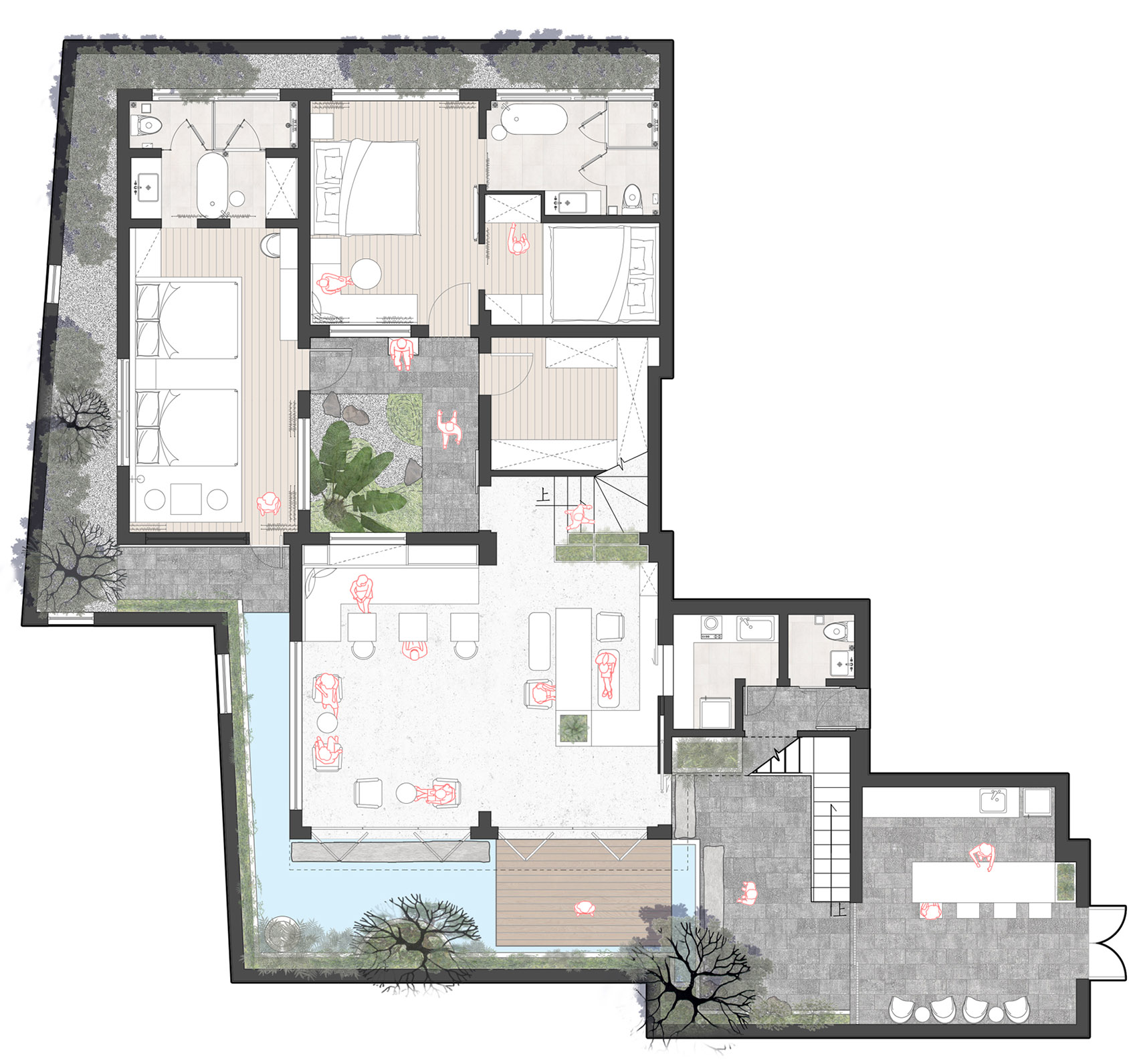
▼二层平面图,second floor plan ©Studio Ininches
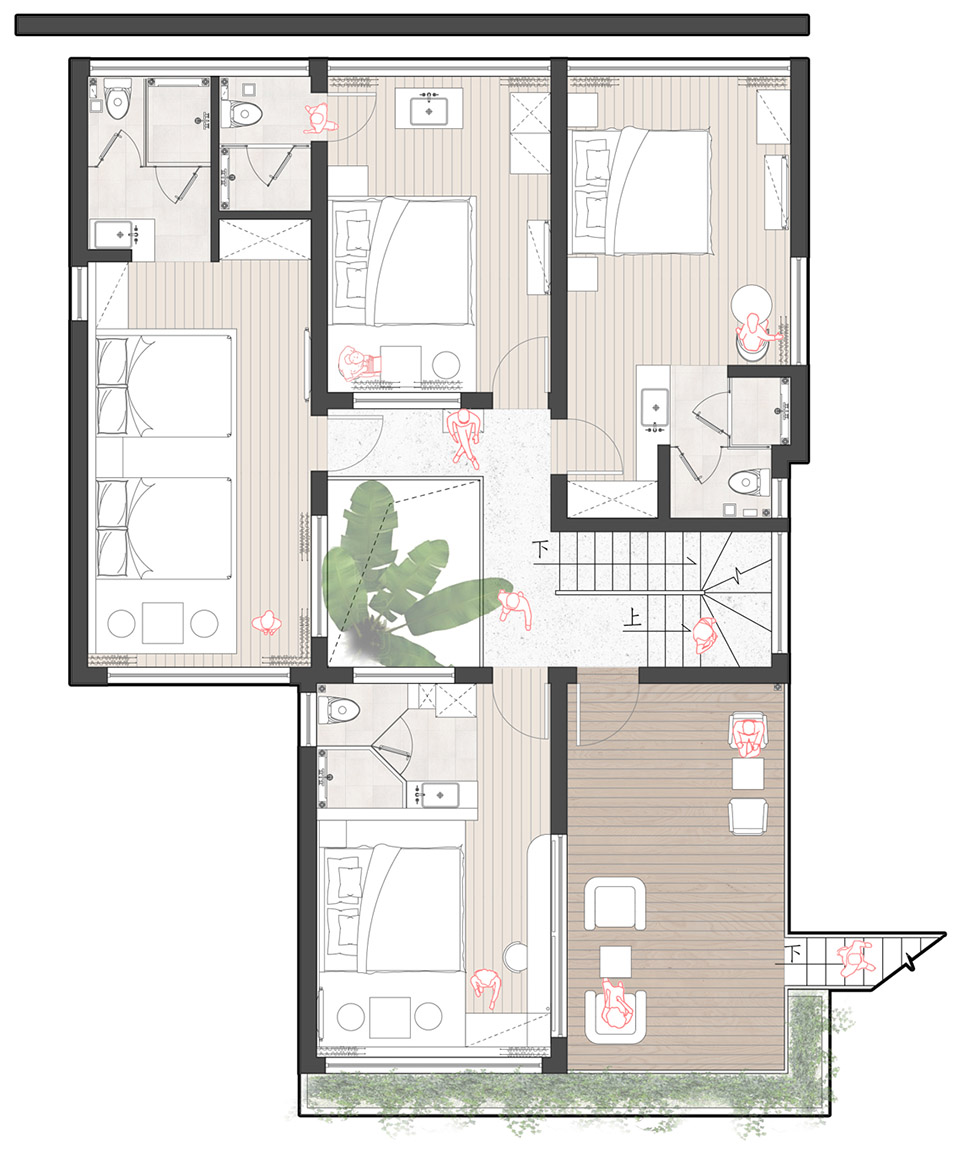
▼三层平面图,third floor plan ©Studio Ininches
